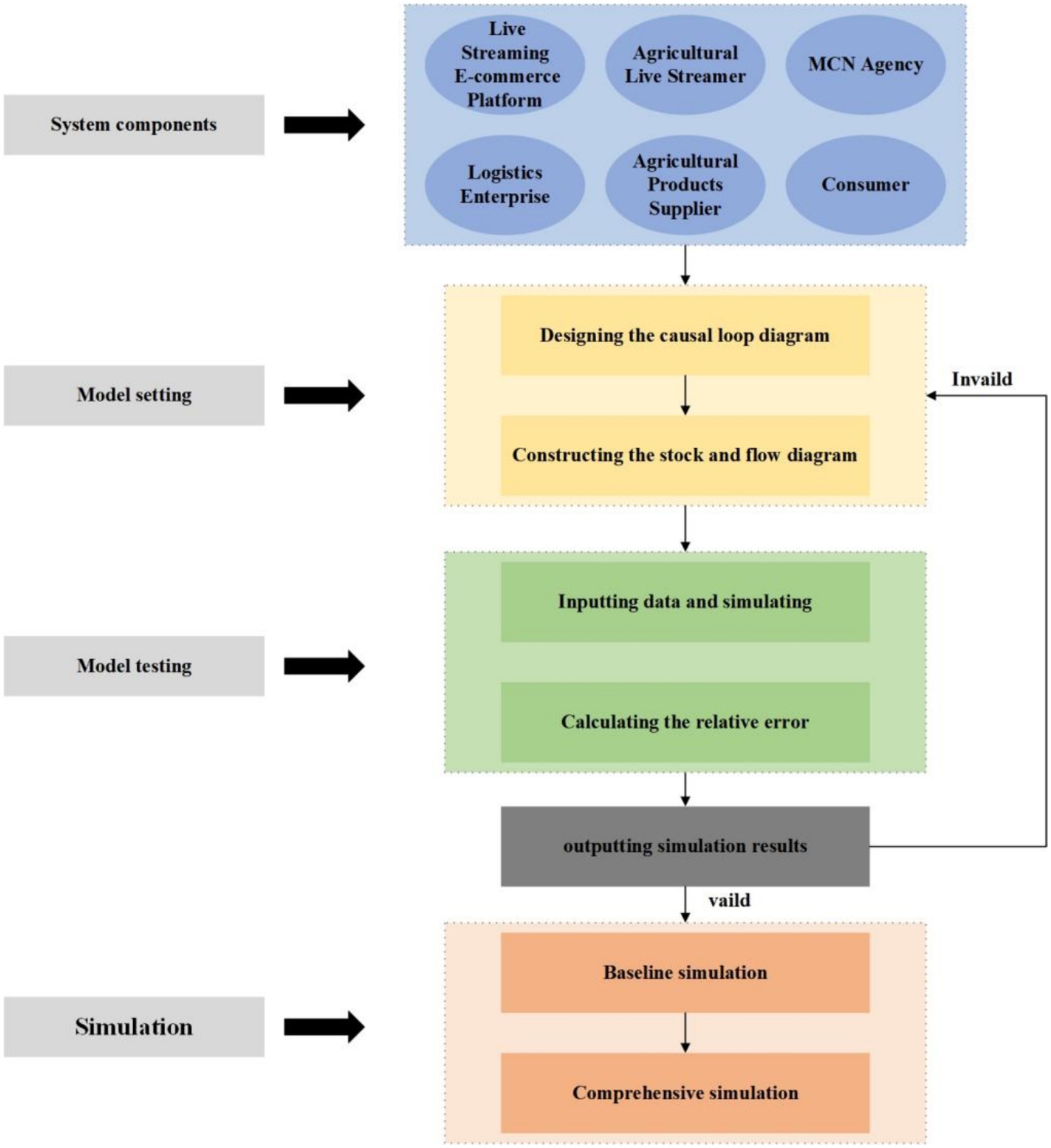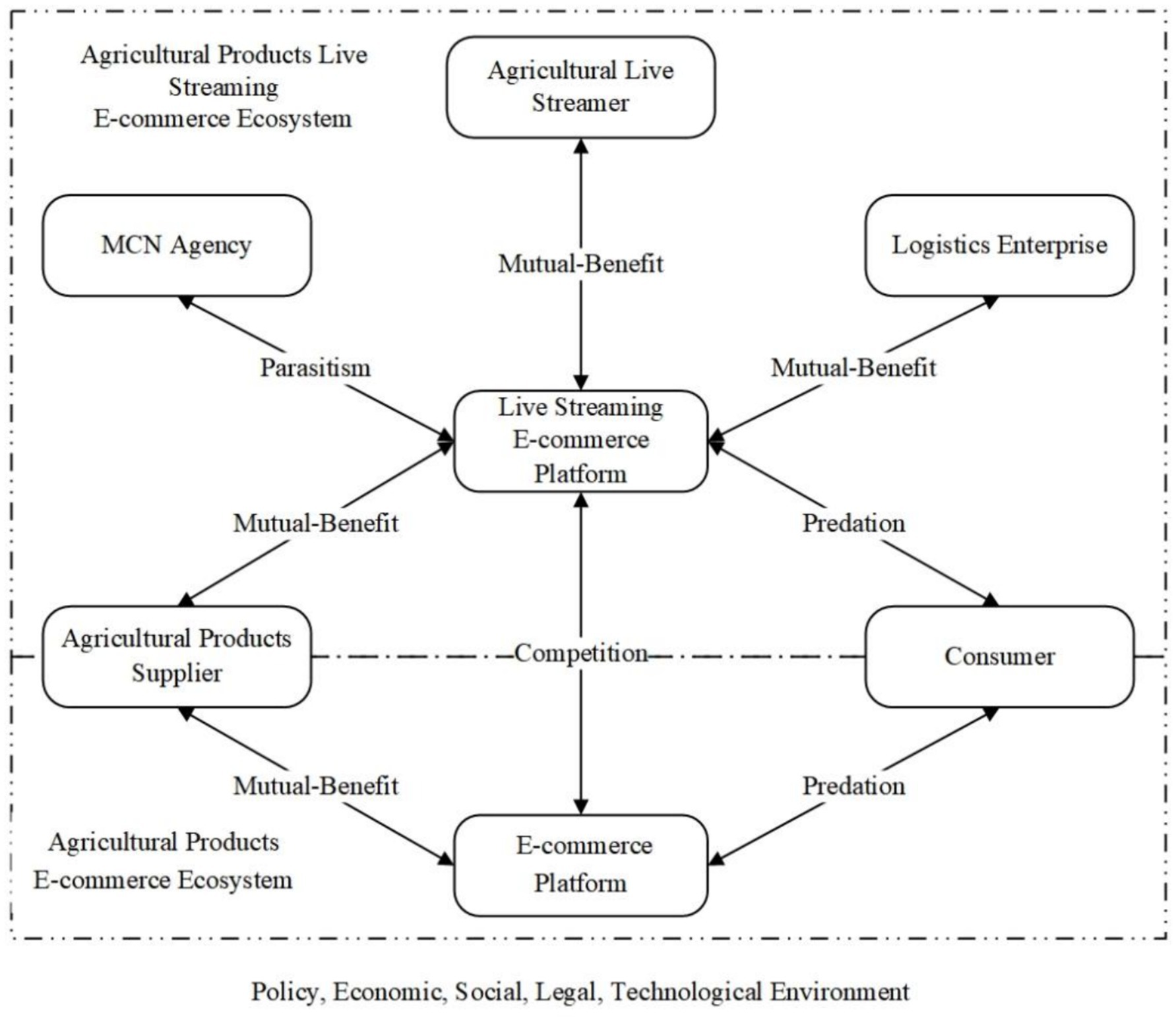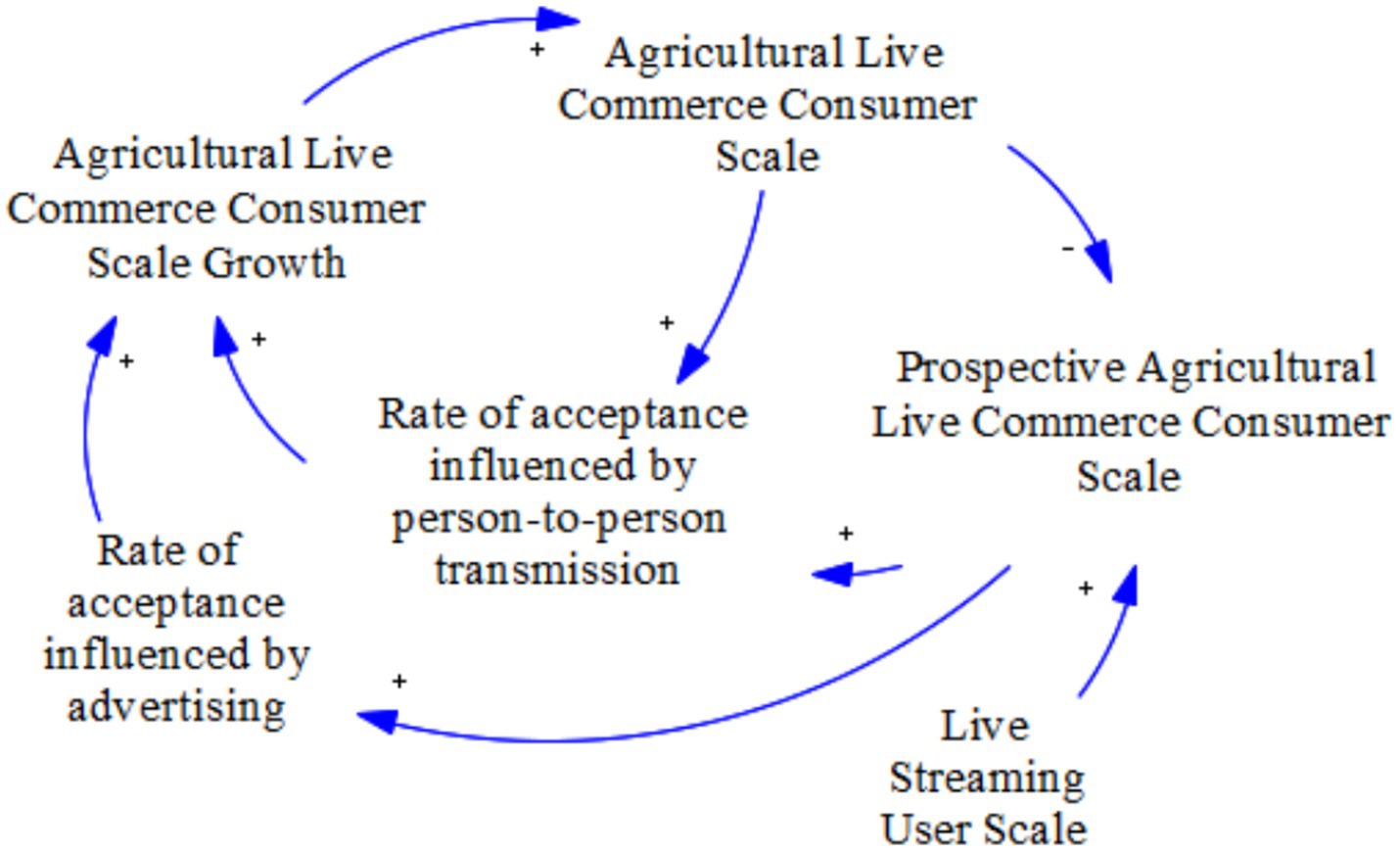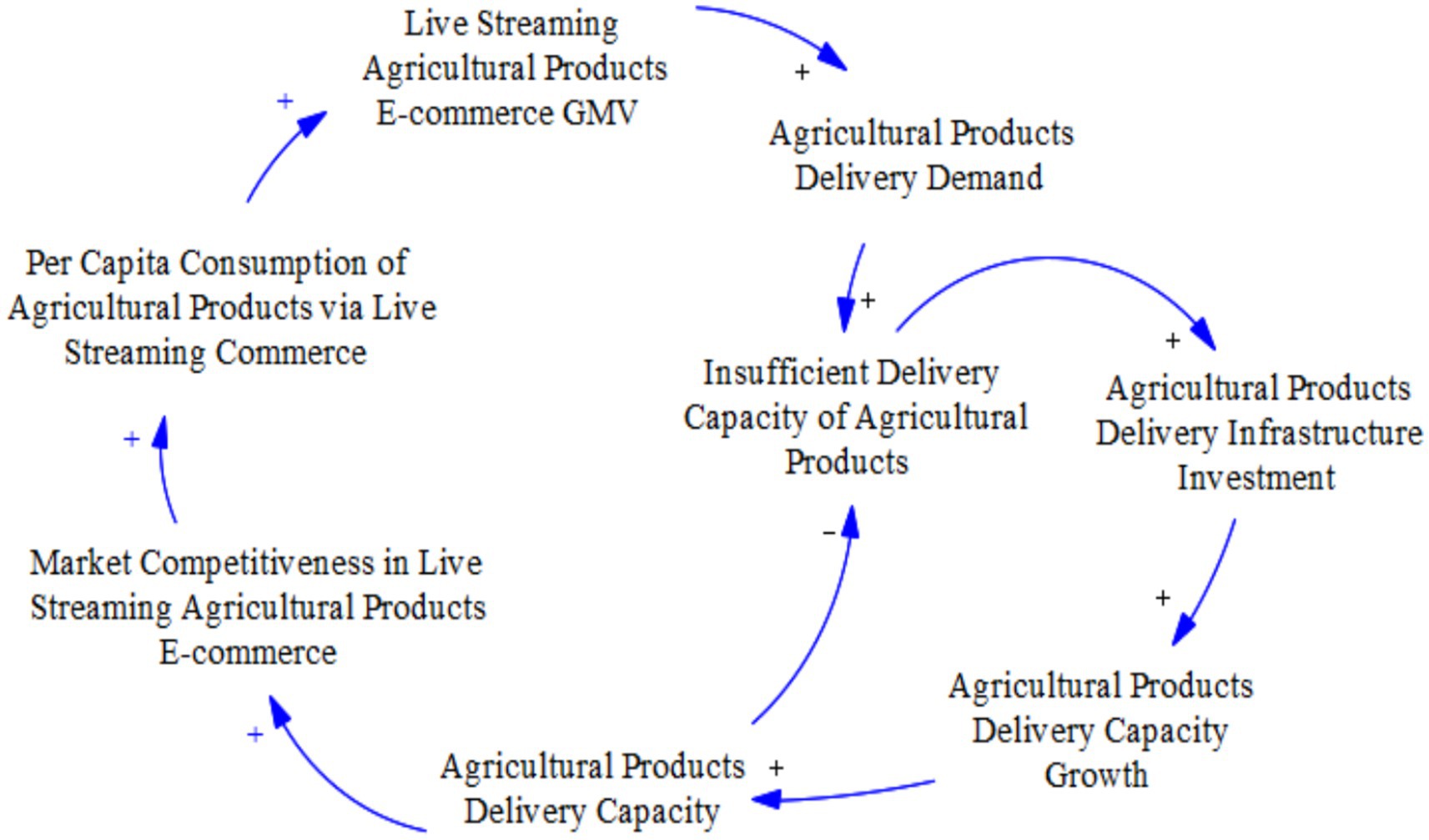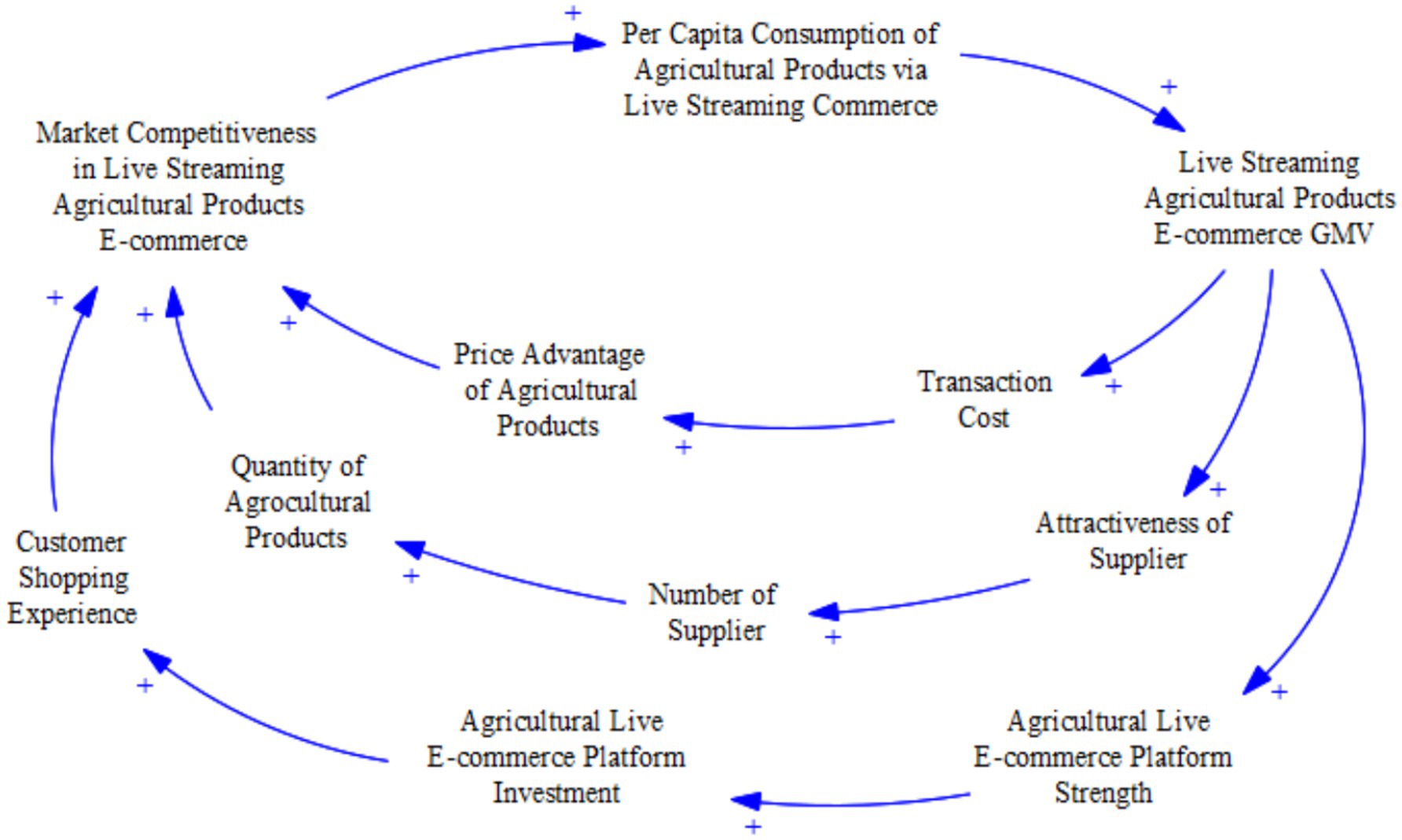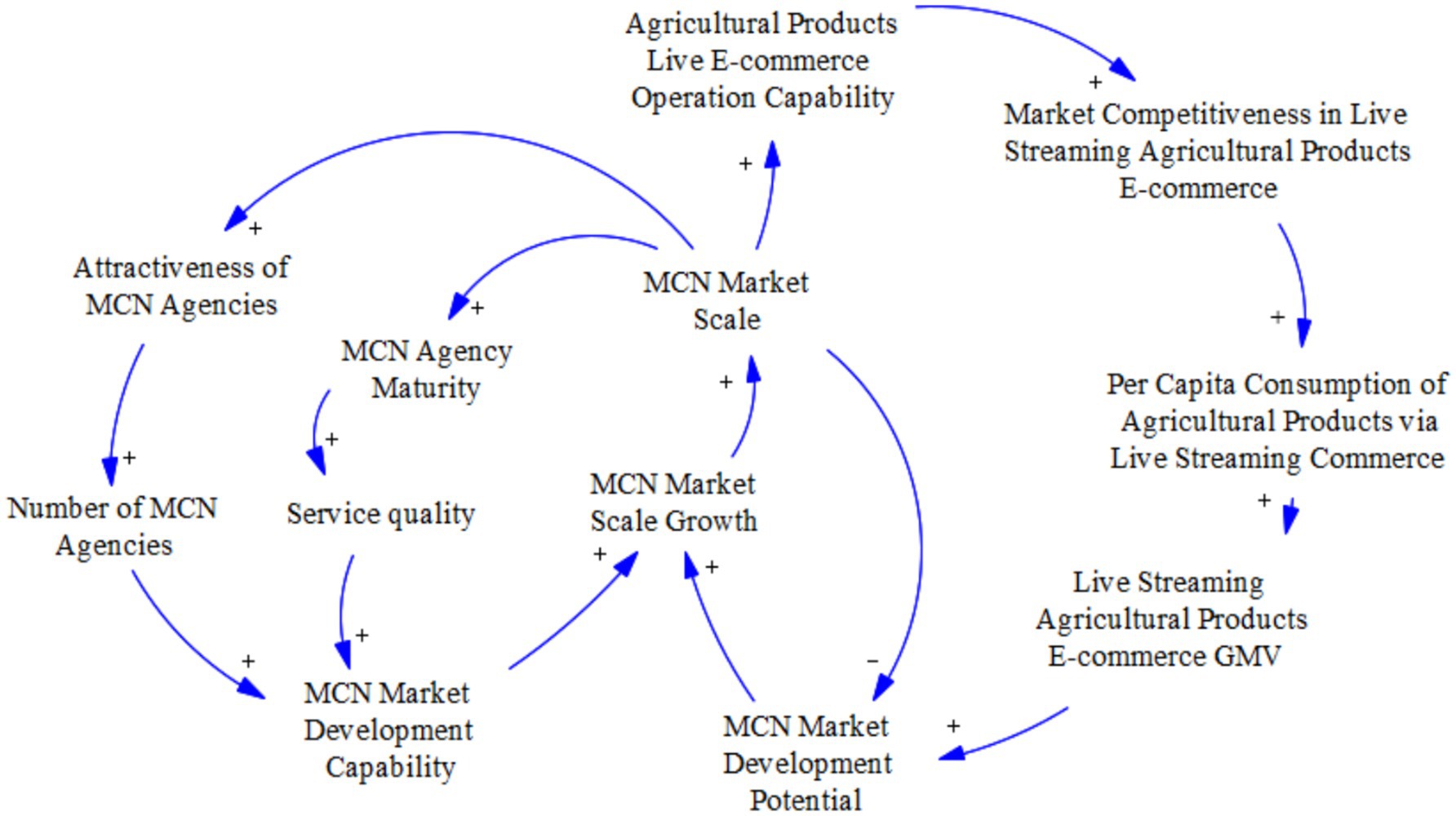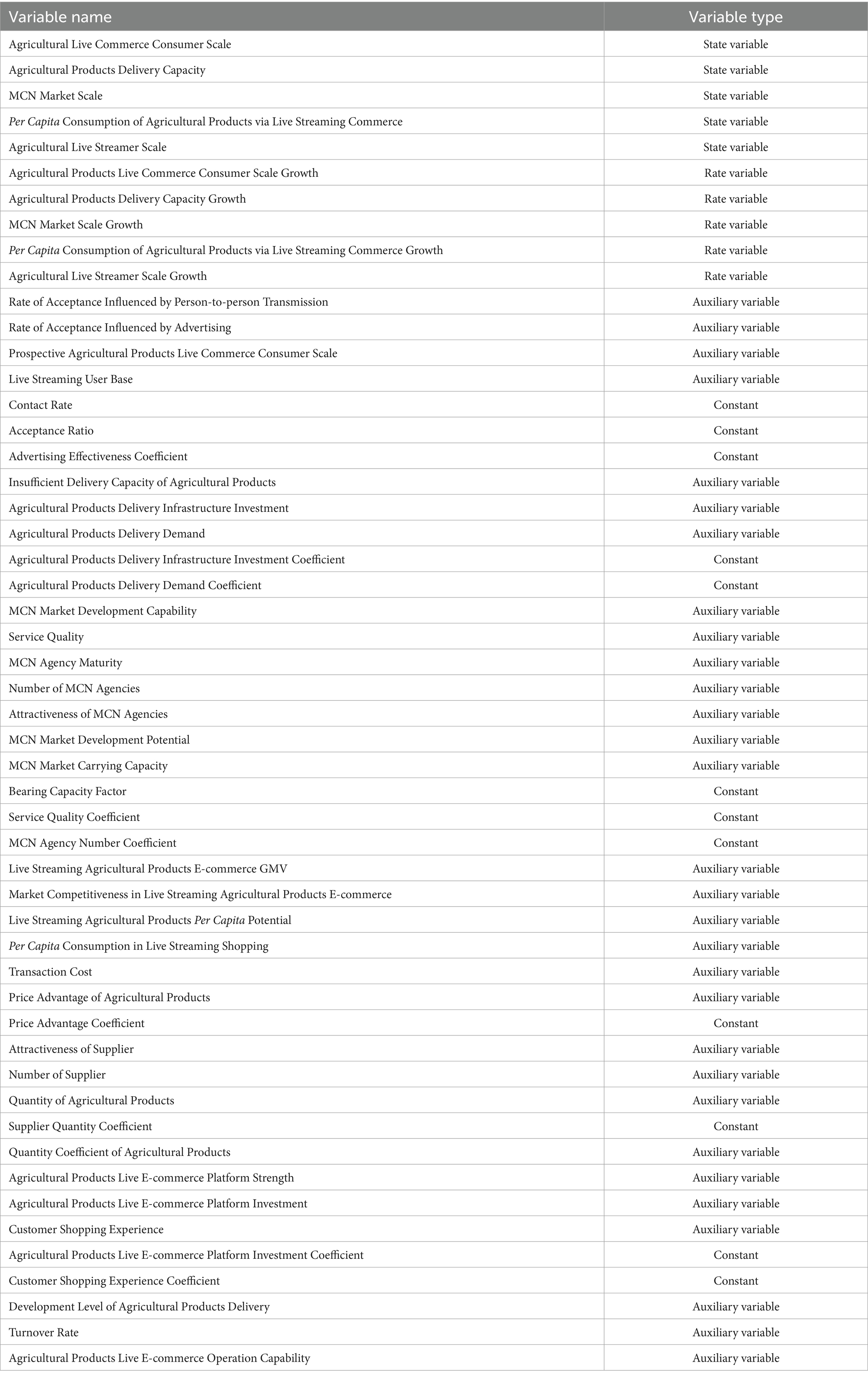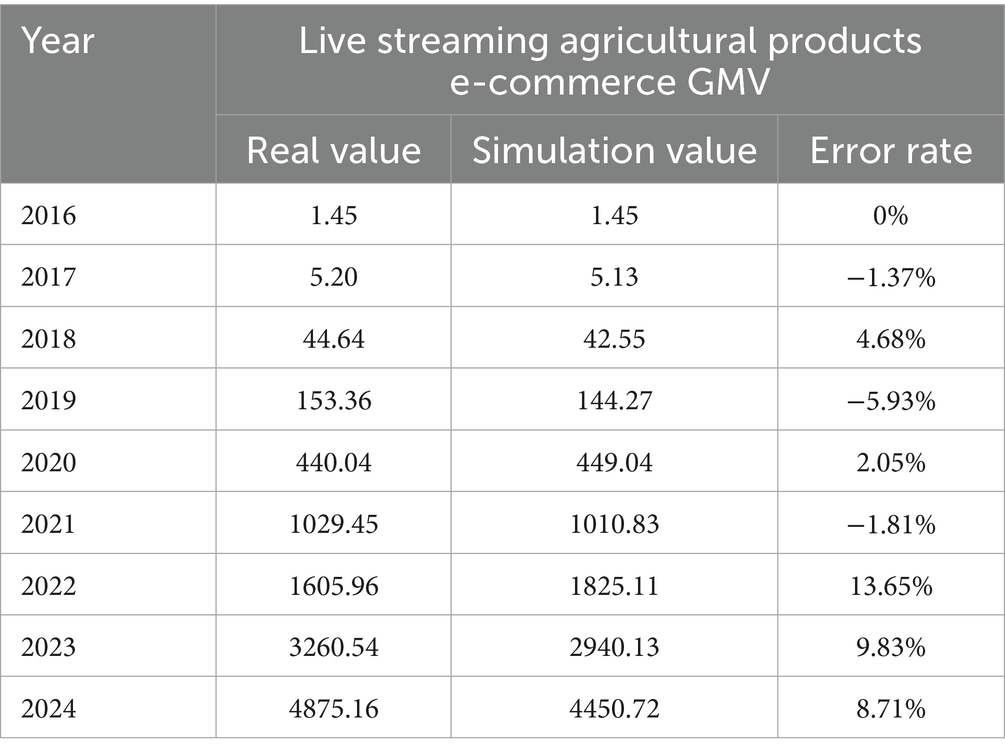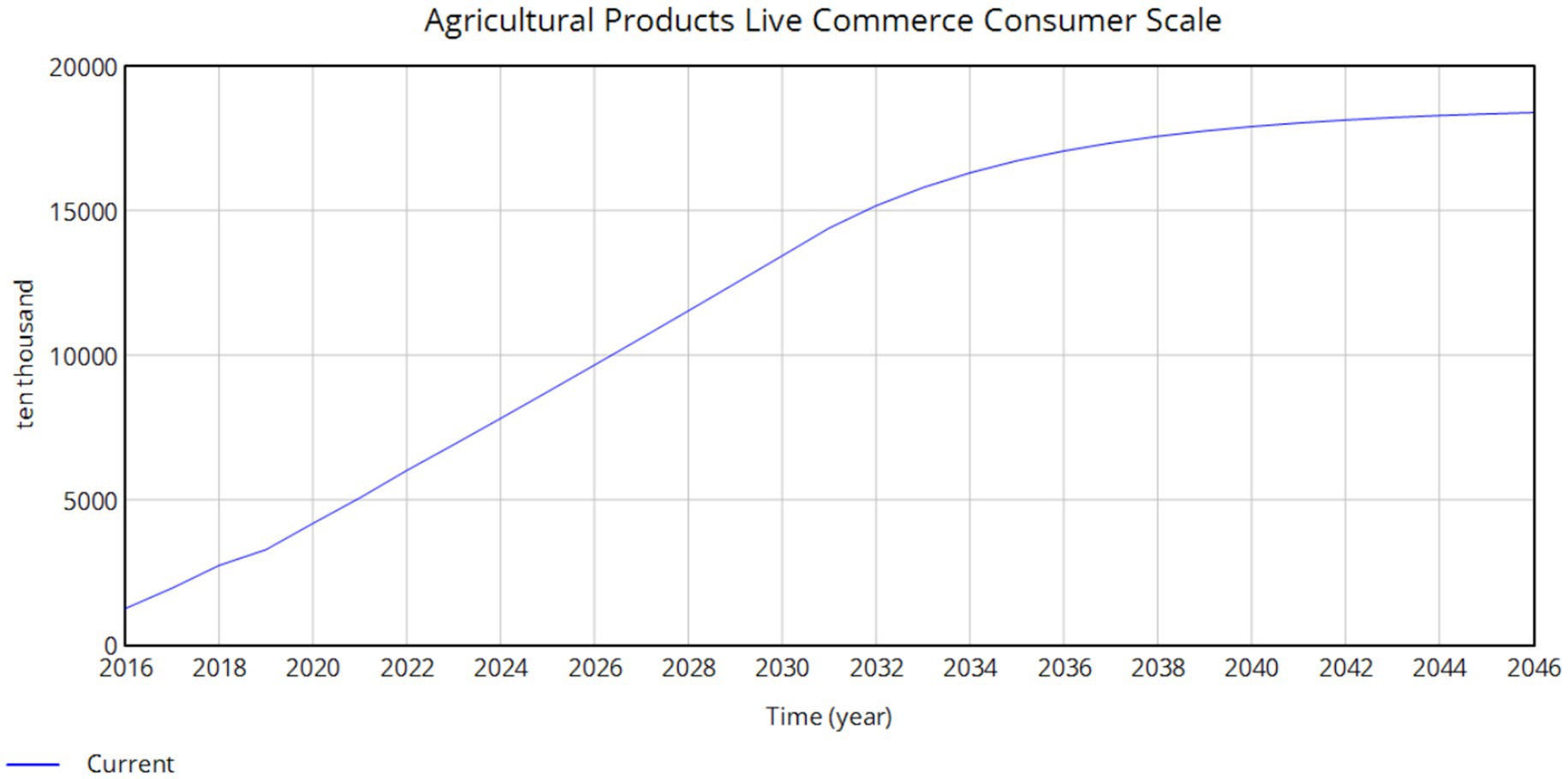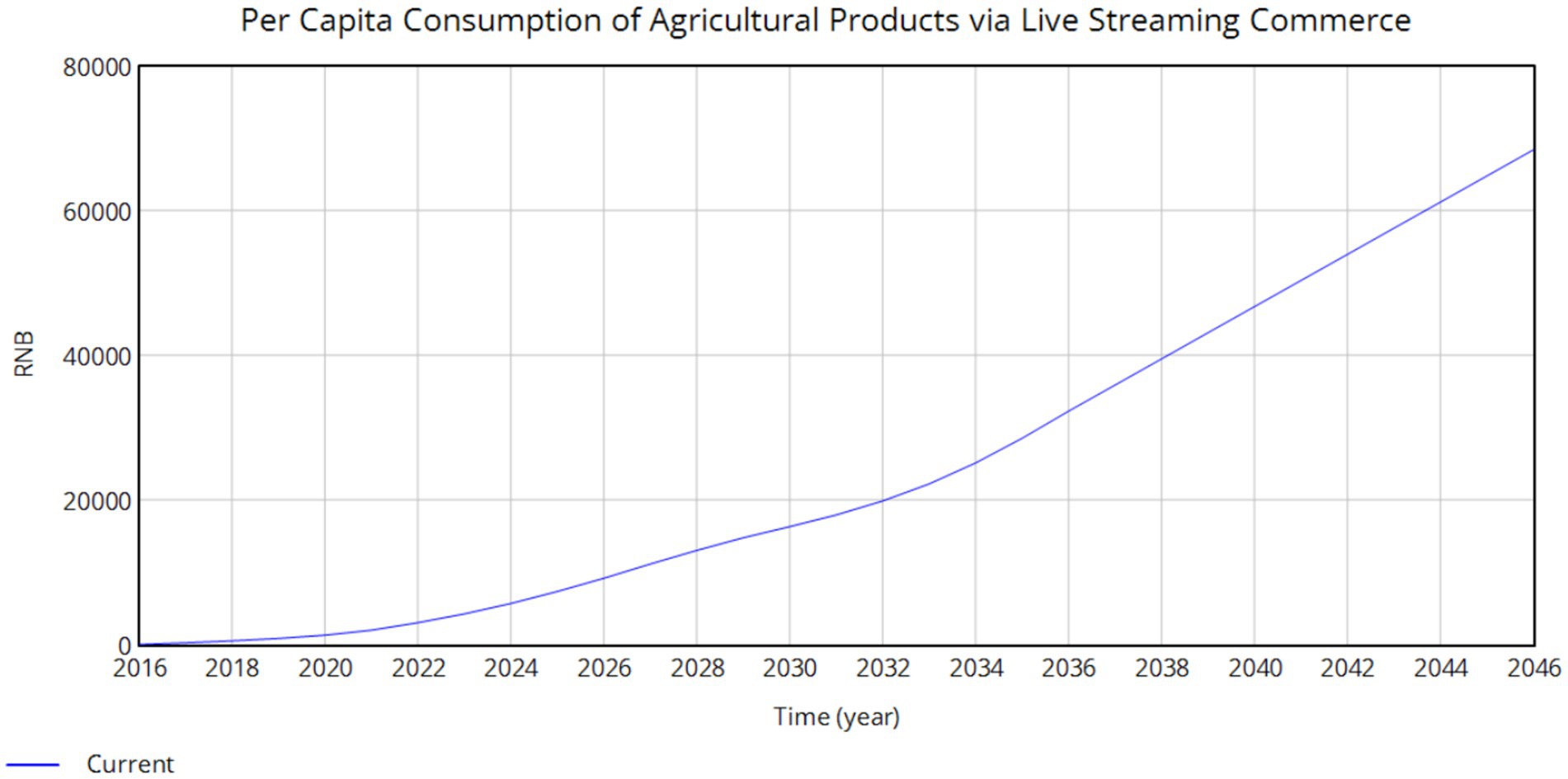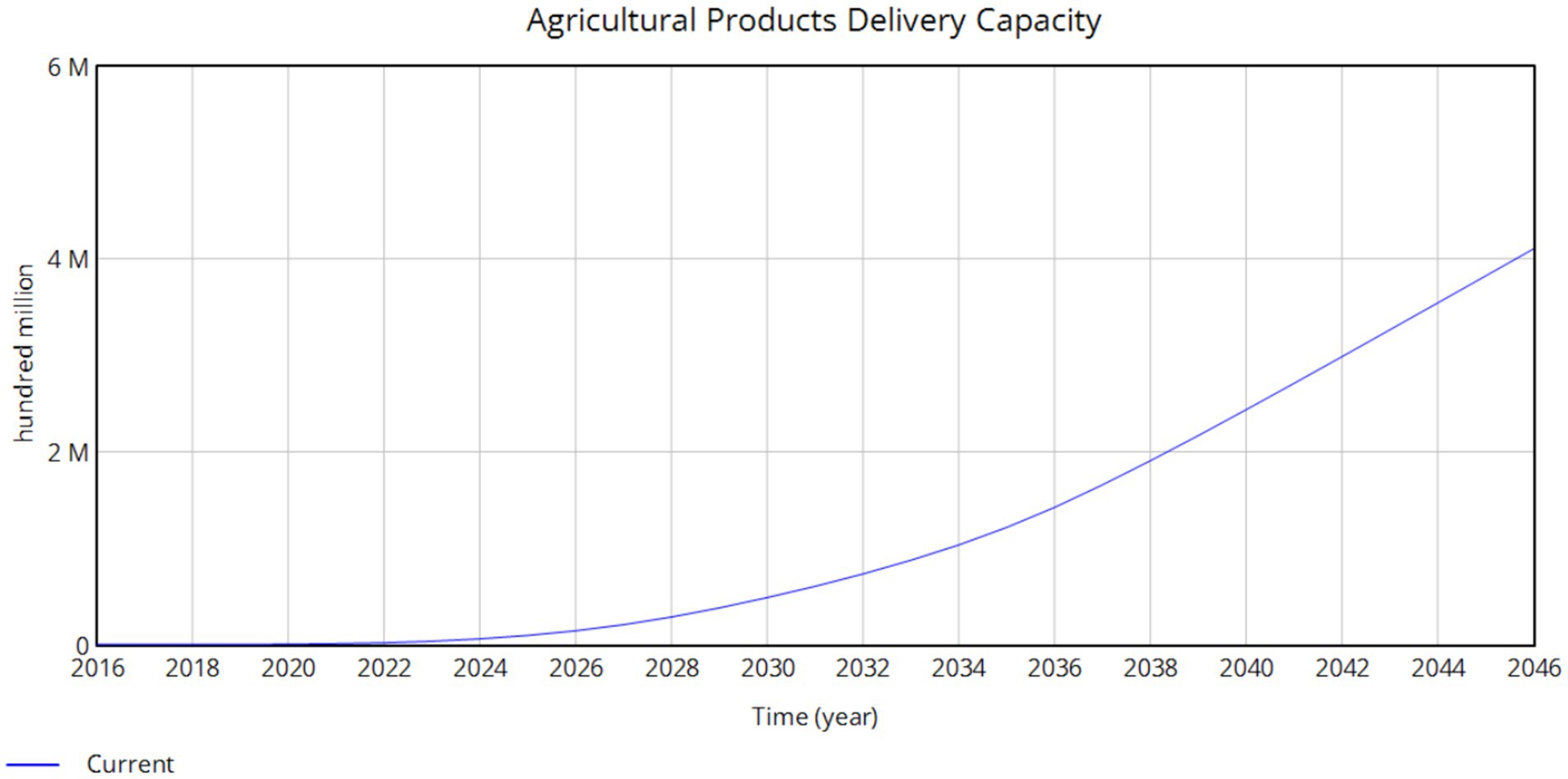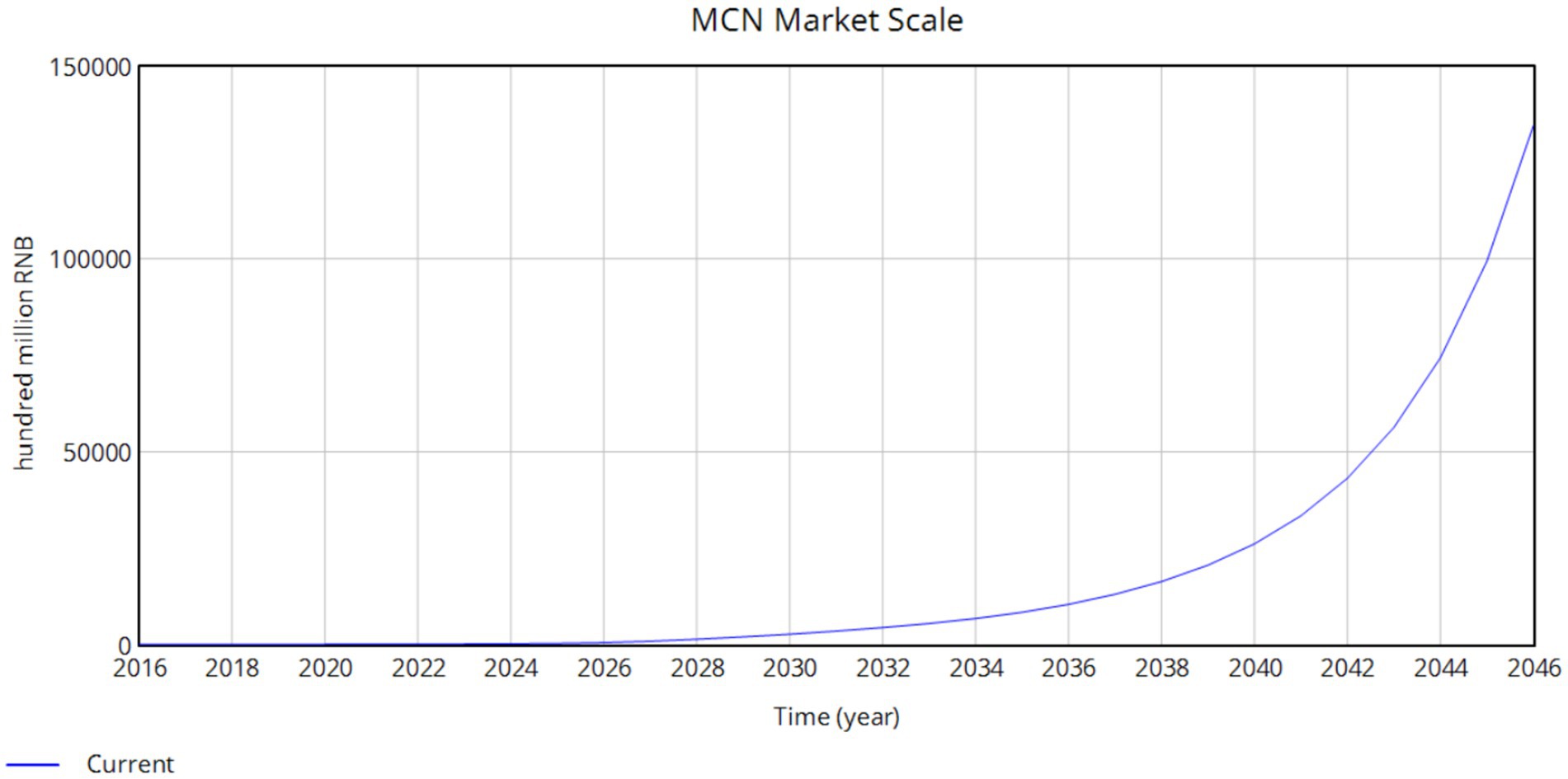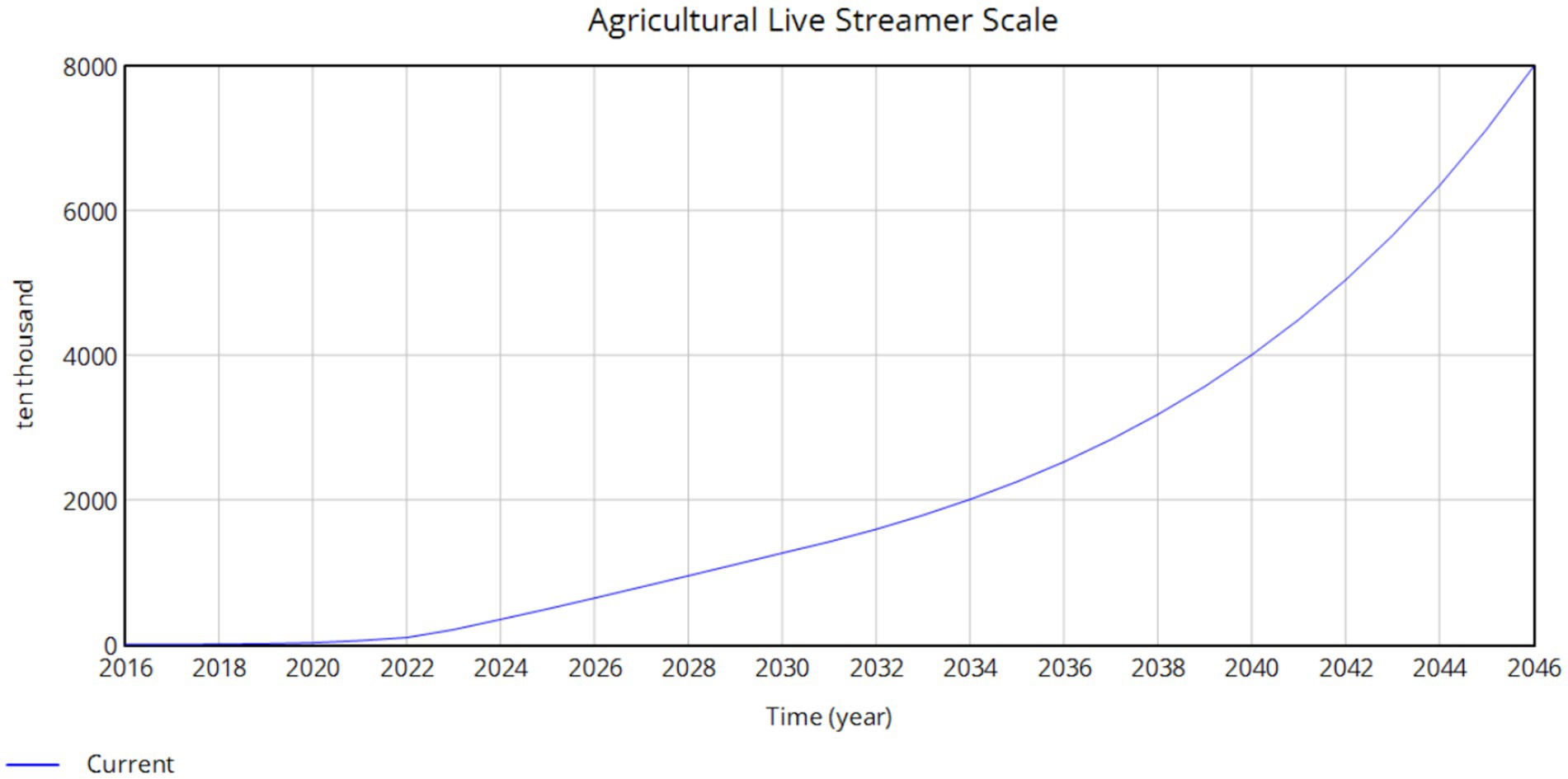- School of Management, Zhengzhou Business University, Gongyi, China
Purpose: This study aims to explore the conceptual framework of the agricultural products live streaming e-commerce ecosystem and construct a theoretical model of the agricultural product live streaming e-commerce ecosystem based on system dynamics. The research findings provide recommendations for the sustainable development of the agricultural product live streaming e-commerce industry.
Design/methodology/approach: This study proposes a conceptual model of the agricultural products live streaming e-commerce ecosystem, analyzes the predation, mutual-benefit, competition, and parasitism relationships among the subjects, such as live streaming platforms, agricultural live streamers, and multi-channel network (MCN) agencies in the system, and uses system dynamics methods to establish causal circuit diagrams and simulation models. Reveal the development trends of key industrial indicators and the extent to which ecological relationships affect the system from 2016 to 2046.
Findings: The simulation results indicate: (1) During the period from 2016 to 2046, all key indicators in the agricultural products live streaming e-commerce ecosystem have shown an upward trend; (2) Competition and parasitism relationships have the most significant impact on the system, while predation and mutual-benefit relationships have a relatively weak influence. In practice, priority should be given to supporting live streaming e-commerce platforms and multi-channel network (MCN) agencies to promote the sustainable development of the industry.
Originality/value: This study employs the system dynamics method and, through qualitative and quantitative analysis, reveals the development laws of the live streaming e-commerce industry for agricultural products, and puts forward practical suggestions, providing a new perspective for research in the field of dynamic development.
1 Introduction
In recent years, the rapid advancement of information technology has brought unprecedented development opportunities to the agricultural products live streaming e-commerce industry, driving its explosive growth. According to iResearch’s estimation, the scale of China’s live streaming e-commerce market reached 4.9 trillion yuan in 2023, with a year-on-year growth rate of 35.2%.1 This figure fully demonstrates the robust growth momentum of the industry. Moreover, the Chinese government has placed significant emphasis on the role of live streaming e-commerce in promoting agricultural and rural modernization as well as rural revitalization. In 2022, the State Council of China issued the “14th Five-Year Plan for Promoting Agricultural and Rural Modernization”2 and the “Opinions of the Central Committee of the Communist Party of China and the State Council on Key Tasks for Comprehensively Advancing Rural Revitalization in 2022”,3 both of which explicitly identify live streaming sales as a crucial tool for boosting rural industrial prosperity and facilitating rural revitalization. These policy initiatives provide strong support for the development of China’s agricultural product live streaming e-commerce industry and are expected to drive its sustained and healthy growth in the future.
With the expansion of agricultural products, live streaming practices, and policy support, an increasing number of market players have entered the industry. Emerging short-video (content) platforms such as “Kuaishou” and “Douyin” have launched agricultural products live streaming sales businesses, while agricultural live streamers, MCN agencies, and logistics enterprises have also ventured into the field, stimulating multiple new economic growth points. Although China’s agricultural products live streaming e-commerce industry has achieved rapid development in a short period, it has also exposed several pressing issues, such as inadequate regulations, a lack of service supervision mechanisms, and shortcomings in supporting facilities like financial services and logistics distribution (Guo and Qu, 2020; Pan, 2021; Wang et al., 2022). Therefore, understanding the internal operational mechanisms of the agricultural product live streaming e-commerce industry and effectively promoting its sustainable development are of great importance.
Currently, some scholars have innovatively introduced ecosystem theory into the study of e-commerce, offering new perspectives and research dimensions for the sustainable development of the field. Unlike natural ecosystems composed of organisms and their environments, the agricultural products live streaming e-commerce ecosystem revolves around live streaming e-commerce platforms, leveraging information technology to integrate various stakeholders—such as agricultural live streamers, live streaming e-commerce platforms, agricultural products suppliers, consumers, MCN agencies, and logistics enterprises—into a cohesive system. These entities collaborate to maximize their value while continuously interacting with external factors such as policies, technology, and legal frameworks, ultimately forming a diverse and dynamic ecosystem. With the advancement of information technology, the agricultural product live streaming e-commerce ecosystem has gained increasing academic attention, as it not only enhances overall social benefits but also amplifies the advantages of live streaming e-commerce.
However, research on the agricultural products live streaming e-commerce ecosystem remains in its early stages, whereas studies on general e-commerce ecosystems and agricultural product e-commerce ecosystems have already yielded rich and systematic findings. For instance, some scholars have systematically explored the theoretical systems of e-commerce ecosystems and agricultural product e-commerce ecosystems, with a focus on their connotations, system structures, relationship structures, and dynamic evolution (Hu et al., 2009; Wang and Ding, 2015; Lei, 2017). As a new type of online retail model integrating social media and traditional e-commerce, agricultural products live streaming e-commerce differs from the e-commerce ecosystem in terms of system structure and population relationship. Therefore, the existing traditional e-commerce theories are difficult to directly explain the core issues, such as the structure, main structure, and dynamic evolution of the agricultural products live streaming e-commerce ecosystem.
Based on this, this study takes the agricultural products live streaming e-commerce ecosystem as the research object. By constructing a system dynamics model, it investigates the subjects, subject relationships, and dynamic development of the agricultural products live streaming e-commerce ecosystem. The main contribution of this study lies in: In terms of theoretical contribution, this study proposes the theoretical concept of the agricultural products live streaming e-commerce ecosystem, reconstructs theoretical issues such as the system structure, relationship structure, and dynamic mechanism of the traditional e-commerce ecosystem, which is conducive to expanding the theoretical system of the traditional e-commerce ecosystem. In terms of management contribution, the development suggestions put forward to fully release the value of the important subjects in the agricultural product live streaming e-commerce ecosystem have positive guiding significance for the healthy development of agricultural product live-streaming e-commerce in terms of direction, thinking, and principle, and can provide references for the formulation and improvement of relevant government policies.
The paper is structured as follows: Section 2 is a literature review. Section 3 is an introduction to the research methodology of the paper, including the system structure and system dynamics model. Section 4 presents the simulation Analysis. Section 5 presents the discussion. Section 6 presents the conclusions and recommendations.
2 Literature review
2.1 Agricultural products E-commerce ecosystem
In the early 21st century, some scholars used the theory of business ecosystem to explain the phenomenon of e-commerce industrial clusters, introducing the concept of the e-commerce ecosystem. They believe that the e-commerce ecosystem is composed of economic consortia that share resources relying on Internet platforms. Drawing from ecological theory, researchers further defined e-commerce ecosystems as complex, interconnected systems where geographically dispersed enterprises and organizations collaborate through internet platforms, exhibiting synergistic and interdependent characteristics similar to natural ecosystems (Hu et al., 2009; Hou and Xu, 2015; Chen and Yang, 2016; You and Peng, 2017). In terms of system composition, e-commerce ecosystems resemble natural ecosystems, comprising populations linked by food-chain relationships (e.g., leading populations, key populations, supportive populations, and parasitic populations) and their external environments (Hu et al., 2009). These populations co-evolve through mutual dependence and collaboration (Lu et al., 2020; Zhang et al., 2021).
In the context of agricultural products e-commerce, research on its ecosystem has reached maturity. Wang and Ding (2015) first proposed the concept of an agricultural products e-commerce ecosystem, defining it as a dynamic organic system involving producers, processors, distributors, consumers, e-commerce firms, stakeholders, and external environments. As rural e-commerce gained prominence, scholars like Huang et al. (2017) and Liang (2019) identified political, economic, cultural, and industrial factors as key environmental elements. Chi and Le (2017) conducted micro-level case studies on Taobao villages, analyzing population structures and formation pathways. Hu et al. (2017) categorized the ecosystem into five components: leading populations, key populations, supportive populations, parasitic populations, and external environments. From existing research, it can be found that the relevant studies on the e-commerce ecosystem of agricultural products focus on issues such as system concepts and system composition, which provide a theoretical basis for the subsequent proposal of the concept and main composition of the live-streaming e-commerce ecosystem of agricultural products in this study.
2.2 Agricultural products E-commerce ecosystem based on SD
The e-commerce ecosystem is a dynamic and complex system, characterized by numerous intricate feedback loops, causal relationships, and interactions throughout its development. As a result, many scholars have employed system dynamics theory to systematically analyze the key influencing factors in the evolution of the e-commerce ecosystem. Li et al. (2020) identified platform construction, cross-border logistics, credit risk management, and talent cultivation as critical factors affecting the cross-border e-commerce ecosystem, and applied system dynamics to conduct quantitative research. Qiao et al. (2023) adopted a system dynamics approach to investigate the drivers of value creation in social e-commerce, finding that product quality, cost-effectiveness, logistics services, product design, and commission incentives are key factors influencing value creation within the social e-commerce ecosystem. Some scholars have explored the dynamic evolution of the e-commerce ecosystem from an ecological perspective. Li et al. (2015) argued that both intra-population and inter-population relationships within the e-commerce ecosystem involve competition and cooperation, and used system simulation methods to model and analyze these relationships. Lei (2017), based on ecological system theory, categorized the populations of the online retail ecosystem into four major types: online retailers, consumers, logistics distribution enterprises, and online retail service outsourcing enterprises. Using system dynamics, he illustrated the predatory, competitive, mutualistic, and parasitic relationships among these populations. Xue et al. (2020) constructed a system dynamics model for the development of the cross-border e-commerce ecosystem and used Vensim PLE software to simulate its development trends. The study found that the transaction scale of cross-border e-commerce in China, the development level of cross-border e-commerce platforms, logistics service levels, comprehensive foreign trade service levels, and certification management levels would all maintain growth trends in the future.
Numerous scholars have also examined the dynamic evolution of the agricultural product e-commerce ecosystem. Guo and Li (2019) developed a system dynamics model to explore the interactive development of rural e-commerce and rural revitalization, revealing the causal relationships and dynamic feedback mechanisms among four subsystems: the number of rural e-commerce merchants, the specialty agricultural product market, the scale of rural e-commerce professionals, and the scale of capital. Zhang et al. (2019) constructed a system dynamics model to simulate the sustained growth and evolution of family-based, company-based, and brand-based merchant groups in Taobao Villages. The research found that the local e-commerce ecological construction significantly influences the transformation and upgrading of these rural Taobao Village merchant groups. Jia and Ni (2025) delineated a system structure model for the development of agricultural product e-commerce platforms, identifying agricultural product transaction volume, product quality, platform operational capability, infrastructure level, and platform service level as key variables measuring the system’s development. From existing research, it is evident that most scholars apply system dynamics theory to the field of e-commerce studies, focusing on exploring the influencing factors and dynamic evolution of the e-commerce ecosystem. This provides a theoretical reference for the subsequent construction of a system dynamics model for the live-streaming e-commerce ecosystem of agricultural products in this study.
2.3 Agricultural products live streaming E-commerce
Agricultural products live streaming e-commerce has become a focal point for both industry and academia. Current research on this topic primarily explores three aspects. The first examines factors influencing consumers’ purchase intentions, predominantly through empirical analyses of live streaming platform data. Studies suggest that interactive features (Liu Z. et al., 2020; Gu, 2020) and social presence (Xie et al., 2019; Zhou et al., 2021) reduce consumers’ uncertainty about product information, thereby enhancing purchase intentions. Similarly, streamer attributes (Sun et al., 2019; Han and Xu, 2020), emotional expressions (Lin et al., 2021; Bharadwaj et al., 2022), expertise (Liu F. et al., 2020; Zhang et al., 2021), popularity (Park and Lin Limin, 2020), and entertainment content (Liu and Shi, 2020) significantly influence consumer behavior. Evidently, streamers are a defining feature of live streaming e-commerce, distinguishing it from traditional e-commerce. Their personal traits, professional knowledge, and social skills foster consumer trust, encouraging participation and purchases.
The second stream of research focuses on governance mechanisms addressing issues such as deceptive marketing, false advertising, and unethical business practices (Hu et al., 2023; Feng, 2023). Some scholars employ evolutionary game theory to construct tripartite or quadripartite regulatory models (Li et al., 2022; Wang and Lin, 2022), proposing governance strategies from the perspectives of streamers, platforms, and regulators (Mei and Hou, 2021; Su, 2021; Liu and Li, 2021). Wang et al. (2022) argues for institutional and ethical constraints to regulate misconduct in live streaming sales. Ye and Rui (2017) emphasizes the need for self-participation mechanisms among content creators and community-building strategies to strengthen platform governance. Pan (2021) advocates for a comprehensive industry governance framework, including stricter regulations, higher entry barriers for streamers, skill enhancement, diversified product offerings, high-quality content creation, and optimized supply chains to foster a fair competitive environment. These recommendations provide critical guidance for the healthy development of the live streaming e-commerce industry.
The third is the research on the sustainable development of the live streaming e-commerce industry. Numerous scholars have provided suggestions for the sustainable normalization of agricultural product live streaming, such as cultivating a talent pool for live streaming (Zan and Wang, 2020), enhancing the quality of live streaming content (Yue, 2020), improving live streaming infrastructure (Zan and Wang, 2020), constructing a reverse supply chain (Hua, 2020), and strengthening industry regulation (Guo and Qu, 2020; Fu, 2021).
2.4 Research gaps
Based on the above literature review, current research on e-commerce ecosystems and agricultural product e-commerce ecosystems appears relatively systematic and well-established. Academic understanding of agricultural product live streaming e-commerce is also deepening, evolving from initial conceptual explanations and situational analyses to broader long-term development issues such as industry governance and sustainable development. However, with the rapid growth of agricultural product live streaming e-commerce, theoretical research in this field still exhibits the following shortcomings: First, a conceptual model of the agricultural product live streaming e-commerce ecosystem has yet to be established. Although academia has developed relatively mature theories regarding (agricultural product) e-commerce ecosystems, these theories are based on findings from traditional e-commerce models and lack consideration of key entities such as live streaming e-commerce platforms, agricultural live streamers, and multi-channel network (MCN) agencies. Consequently, their theoretical frameworks cannot be directly applied to this study (Hu et al., 2009; Wang and Ding, 2015; Lei, 2017; Xue et al., 2020). Second, there is a lack of comprehensive analysis of the agricultural products live streaming e-commerce ecosystem from a systems theory perspective. Existing studies predominantly focus on typical cases, such as specific enterprises or Taobao villages, and are largely qualitative in nature (Zeng et al., 2022; Xiao et al., 2025). Few scholars have employed system dynamics methods to deeply analyze the causal relationships and development trends among various entities within the agricultural products live-streaming e-commerce ecosystem. Therefore, building on previous research, this study aims to apply the principles and methods of system dynamics to construct a model of the agricultural products live streaming e-commerce ecosystem. By emphasizing the analysis of causal relationships among entities within the system, it seeks to further reveal the operational mechanisms of the system and clearly delineate the development trends of its key actors.
3 Research methodology
System dynamics is an applied discipline that closely integrates systems science theory with computer simulation to study system feedback structures and behaviors, serving as an effective method for analyzing complex systems (Forrester, 1971). The agricultural products live streaming e-commerce ecosystem not only has an intricate internal structure but also exhibits complex and dynamic interactions with external environments. Therefore, the system dynamics method is well-suited for analyzing the development mechanism of this ecosystem. As Figure 1 depicts, this paper’s system dynamics modeling framework comprises four key steps: system components, modeling setting, modeling testing, and simulation. The first step is to clarify the system components. The system components mentioned in this paper mainly include a live streaming e-commerce platform, agricultural live streamer, MCN agency, logistic enterprise, agricultural products supplier, and consumer. The second step is model setting, which involves describing the system structure, defining the feedback relationships among them, and drawing the causal loop diagram and inventory flow chart. On this basis, a mathematical model was constructed, and equations defining the relationships between variables were established. The third step is model validation, which involves verifying the validity of the model by calculating the relative errors of key variables. If the calculated relative error is large, it may be necessary to adjust the parameter values or select model variables. The model was optimized based on the simulation results, which enhanced the credibility and application value of the model. The last step is model simulation. In this paper, Vensim PLE 10.1.3 software is used to simulate the system operation over time. By adjusting the parameters of the key variables, the corresponding dynamic evolution results are obtained. We designed a baseline scenario to simulate and predict the development trend of the system.
3.1 System components
Agricultural products live streaming e-commerce transactions involve the “three flows” between buyers and sellers: information flow, capital flow, and logistics flow. Therefore, in the agricultural products live streaming e-commerce ecosystem, in addition to the buyer population (primarily including suppliers and retailers) and the seller population (mainly consumers), there are enablers of information flow—live streaming e-commerce platforms and agricultural live streamers—and enablers of logistics enterprises. Additionally, due to professionalization and cost advantages, there are also MCN agencies that serve agricultural live streamers.
Thus, this study categorizes the main entities of the agricultural product live streaming e-commerce ecosystem into six types: live streaming e-commerce platforms, agricultural live streamers, MCN agencies, logistics enterprises, consumers, and agricultural products suppliers.
(1) Live streaming e-commerce platform
The live streaming e-commerce platform is the core entity in the agricultural products live streaming e-commerce ecosystem. In this study, live streaming e-commerce platforms primarily include e-commerce platforms and content platforms (Xiao et al., 2025), such as Taobao and Douyin. These platforms serve as critical intermediaries for facilitating live transactions and coordinating resources. By integrating logistics services, payment solutions, and other functions, live commerce platforms enhance scalability and ecosystem development, reducing transaction costs and improving efficiency. This attracts users, suppliers, and brands to the platform, forming a public traffic pool.
(2) Agricultural live streamer
Agricultural live streamers act as a bridge between agricultural product suppliers and consumers during live transactions (Zeng et al., 2022). Their primary function is to provide a transaction medium, ultimately achieving supply–demand matching. In the ecosystem, agricultural live streamers introduce and promote agricultural products to consumers in live sessions, while consumers interact via text and voice, helping them determine whether the products meet their needs. Additionally, streamers gain followers by creating short videos and offering incentives during live streams, converting the platform’s public traffic into private traffic (Xiao et al., 2025).
(3) Multi-channel network (MCN) agency
MCN agencies provide operational support for the collaborative development of live commerce platforms and agricultural live streamers in the ecosystem. They play roles in content production, campaign management, and streamer branding (Xiao et al., 2025). In the agricultural products live streaming e-commerce ecosystem, MCN agencies are key drivers of scalability and market expansion, ensuring the ecosystem’s smooth operation.
(4) Logistics enterprise
Logistics enterprises play a crucial role in the ecosystem by managing the physical flow of goods—transporting products from production sites to end consumers efficiently, accurately, and securely (Wang, 2021). High-quality logistics services enhance the competitiveness of live commerce platforms, attracting more consumers. Thus, logistics enterprises must continuously optimize delivery processes and improve service levels to strengthen the platform’s competitive edge.
(5) Customer
Consumers are the end-users in the agricultural product live streaming e-commerce ecosystem (Wang, 2021). As a core component, their purchasing feedback accurately reflects the ecosystem’s operational efficiency, guiding streamers and suppliers to better understand consumer needs and improve service quality. Meeting consumer demands ensures the ecosystem’s efficient functioning.
(6) Agricultural products supplier
Agricultural products suppliers are the providers of agricultural products in the ecosystem, serving as direct producers, owners, or aggregators (Wang, 2021). Their core responsibility is to supply fresh or processed agricultural products that meet market demand with quality and safety assurances. Suppliers are highly diverse, including individual farmers, professional growers, agricultural cooperatives, family farms, agribusinesses, and processing enterprises. Without stable and reliable suppliers, the entire live streaming e-commerce chain would cease to function.
3.2 Components relationship
In natural ecosystems, interspecies relationships include predation, competition, mutual-benefit, commensalism, amensalism, neutrality, and parasitism. For research convenience, this study focuses on four key relationships: predation, mutual-benefit, parasitism, and competition.
(1) Predation relationship
Predation refers to a relationship where one organism consumes another (Lei, 2017). In the agricultural product live streaming e-commerce ecosystem, this relationship exists between live commerce platforms and consumers. Platforms attract consumers through advertising and word-of-mouth, influencing their trust. High trust levels lead to repeat purchases (Lei, 2017).
(2) Mutual-benefit relationship
Mutual-benefit describes a relationship where two species depend on each other for mutual benefit through resource integration and information exchange (Hu et al., 2009). In the ecosystem, mutualism exists between live commerce platforms and logistics enterprises, agricultural live streamers, and suppliers, fostering reciprocal growth.
(3) Competition relationship
Competition occurs when entities vie for the same resources (Hu et al., 2009). In the ecosystem, competition arises among commercial entities seeking to maximize their interests, particularly between e-commerce platforms and content platforms, as well as between broader live streaming e-commerce ecosystems and traditional e-commerce ecosystems. To maintain competitive advantages, platforms enhance pricing strategies and service quality to boost market share.
(4) Parasitism relationship
Parasitism involves one organism relying on another for survival (Hu et al., 2009). In the ecosystem, this relationship exists between live commerce platforms and MCN agencies. MCN agencies depend on live streaming commerce for existence—they thrive with its growth and decline with its demise. These agencies provide services such as live marketing and technical support to streamers and platforms (Figure 2).
3.3 Causality analysis
Similar to natural ecosystems, the agricultural product live streaming e-commerce ecosystem is an open, non-equilibrium, self-organizing complex system. Analyzing its developmental dynamics proves challenging with conventional linear methods. System dynamics, as a discipline studying information feedback systems, is particularly suitable for examining the development of complex socio-economic and ecological systems. Therefore, this study employs system dynamics methodology to investigate the dynamic development of agricultural product live streaming e-commerce ecosystems.
Based on the conceptual model of agricultural products live streaming e-commerce ecosystems, causal loop diagrams are constructed for four key relationships: predation, mutual-benefit, competition, and parasitism.
(1) Causal loop diagram of predation relationship
In agricultural products live streaming e-commerce ecosystems, the predation relationship primarily exists between live streaming e-commerce platforms and consumers. Essentially, this relationship represents the process where live streaming e-commerce attracts customers by creating superior value compared to traditional e-commerce. This study defines consumers who have made at least one agricultural product purchase via live streaming within a given period as agricultural product live streaming consumers. Building upon the Bass diffusion model, we identify two key drivers for consumers adopting live streaming purchases: merchant advertising and word-of-mouth transmission from existing live streaming consumers. Thus, the scale of agricultural product live streaming consumers is primarily influenced by advertising efforts and interpersonal communication.
The predation relationship causal loop diagram is shown in Figure 3.
Rate of acceptance influenced by person-to-person transmission→ + Agricultural Products Live Commerce Consumer Scale Growth→ + Agricultural Products Live Commerce Consumer Scale→ + Rate of acceptance influenced by person-to-person transmission.
Rate of Acceptance Influenced by Advertising→ + Agricultural Products Live Commerce Consumer Scale Growth→ + Agricultural Products Live Commerce Consumer Scale→–Prospective Agricultural Live Commerce Consumer Scale→ + Rate of Acceptance Influenced by Advertising.
Prospective Agricultural Products Live Commerce Consumer Scale→ + Rate of acceptance influenced by person-to-person transmission→ + Agricultural Products Live Commerce Consumer Scale Growth→ + Agricultural Products Live Commerce Consumer Scale→–Prospective Agricultural Products Live Commerce Consumer Scale→ + Rate of Acceptance Influenced by Advertising.
(2) Causal loop diagram of mutual-benefit relationship
Within agricultural products live streaming e-commerce ecosystems, mutual benefit mainly occurs between live streaming e-commerce platforms and logistics enterprises, streamers, and agricultural products suppliers. For research convenience, this study focuses on the mutual-benefit relationships between live streaming e-commerce platforms and logistics enterprises, as well as agricultural live streamers. The symbiotic relationship between platforms and logistics enterprises drives increased delivery demand, prompting logistics providers to enhance their distribution capabilities to meet market needs. When agricultural product logistics capacity fails to meet robust market demand, delivery capacity shortages emerge. To address this, logistics enterprises must increase investments in distribution infrastructure and technology while optimizing processes to improve efficiency. Therefore, agricultural product delivery capacity is primarily affected by both increasing delivery demand and existing capacity shortages.
The mutual-benefit relationship causal loop diagram is shown in Figure 4.
Live Streaming Agricultural Products E-commerce GMV → +Agricultural Products Delivery Demand→–Insufficient Delivery Capacity of Agricultural Products→ + Agricultural Products delivery Infrastructure Investment→ + Agricultural Products Delivery Capacity Growth→ + Per Capita Consumption of Agricultural Products via Live streaming Commerce→ + Agricultural Products Delivery Capacity→ + Live streaming Agricultural Products E-commerce GMV.
Agricultural Products delivery Infrastructure Investment→ + Agricultural Products Delivery Capacity Growth→ + Agricultural Products Delivery Capacity→–Insufficient Delivery Capacity of Agricultural Products→ + Agricultural Products delivery Infrastructure Investment.
(3) Causal loop diagram of competition relationship
In agricultural product live streaming e-commerce ecosystems, competition primarily exists between live streaming platforms and traditional agricultural e-commerce platforms. Based on Professor McNair’s Wheel of Retailing theory, retail industry development exhibits distinct cyclical characteristics. Emerging retail formats gradually capture market share from traditional models through competitive advantages like service optimization and pricing. Similarly, as an innovative format, live streaming e-commerce attracts increasing numbers of consumers, shifting their purchasing behavior from traditional online shopping to live streaming purchases. This behavioral shift fundamentally stems from changes in purchasing decisions, influenced by multiple factors including agricultural product price advantages, product variety, and user experience.
The competition relationship causal loop diagram is shown in Figure 5.
Price Advantage of Agricultural Products→ + Market Competitiveness in Live streaming Agricultural Products E-commerce→ + Per Capita Consumption of Agricultural Products via Live streaming Commerce → + Live streaming Agricultural Products E-commerce GMV → +Transaction Cost→ + Price Advantage of Agricultural Products.
Quantity of Agricultural Products→ + Market Competitiveness in Live streaming Agricultural Products E-commerce→ + Per Capita Consumption of Agricultural Products via Live streaming Commerce → + Live streaming Agricultural Products E-commerce GMV → +Attractiveness of Supplier→ + Number of Supplier→ + Quantity of Agricultural Products.
Customer Shopping Experience→ + Market Competitiveness in Live streaming Agricultural Products E-commerce→ + Per Capita Consumption of Agricultural Products via Live streaming Commerce → + Live streaming Agricultural Products E-commerce GMV → +Agricultural Products Live E-commerce Platform strength→ + Agricultural Products Live E-commerce Platform Investment→ + Customer Shopping Experience.
(4) Causal loop diagram of parasitism relationship
Within agricultural products live streaming e-commerce ecosystems, parasitism mainly exists between live commerce platforms and MCN agencies. This parasitic relationship means the MCN market expands alongside the growth of agricultural product live streaming e-commerce transactions. As consumer enthusiasm for live streaming purchases grows and transaction volumes increase, MCN agencies gain greater market development potential. To meet market demands, MCN agencies continuously improve service quality and scale, thereby enhancing their market development capabilities. Thus, the parasitic relationship between streamers and MCN agencies promotes MCN market growth by increasing both market potential and development capacity.
The parasitism relationship causal loop diagram is shown in Figure 6.
Live streaming Agricultural Products E-commerce GMV → +MCN Market Development Potential→ + MCN Market Scale Growth→ + MCN Market Scale→ + Agricultural Products live E-commerce Operation Capability→ + Market Competitiveness in Live streaming Agricultural Products E-commerce→ + Per Capita Consumption of Agricultural Products via Live streaming Commerce → + Live streaming Agricultural Products E-commerce GMV.
MCN Market Development Potential→ + MCN Market Scale Growth→ + MCN Market Scale→ + MCN Market Development Potential.
Market Development Capability→ + MCN Market Scale Growth→ + MCN Market Scale→+.
Market Development Capability→ + MCN Market Scale Growth→ + MCN Market Scale→ + Market Development Capability→ + Attractiveness of MCN Agencies→ + Number of MCN Agencies → + Market Development Capability.
3.4 System flowchart and parametric equation
3.4.1 System flowchart and variables
The system flowchart can reflect the structure and characteristics of the system by detailing system variables and establishing corresponding mathematical equations based on logical relationships among variables, thereby enabling quantitative system description.
In this study, based on the previous causality analysis, a system flowchart is constructed. This flowchart consists of four components: predation, mutual-benefit, competition, and parasitism. Within the system dynamics flowchart of the agricultural product live streaming e-commerce ecosystem, there are five state variables: Agricultural Product Live Streaming Consumer Scale; Agricultural Product Logistics Delivery Capacity; Farmer Streamer Scale; MCN Market Scale; Per Capita Consumption of Agricultural Products via Live Streaming Commerce. The system dynamics flowchart and the specific variables are clear to see in Figure 7 and Table 1.
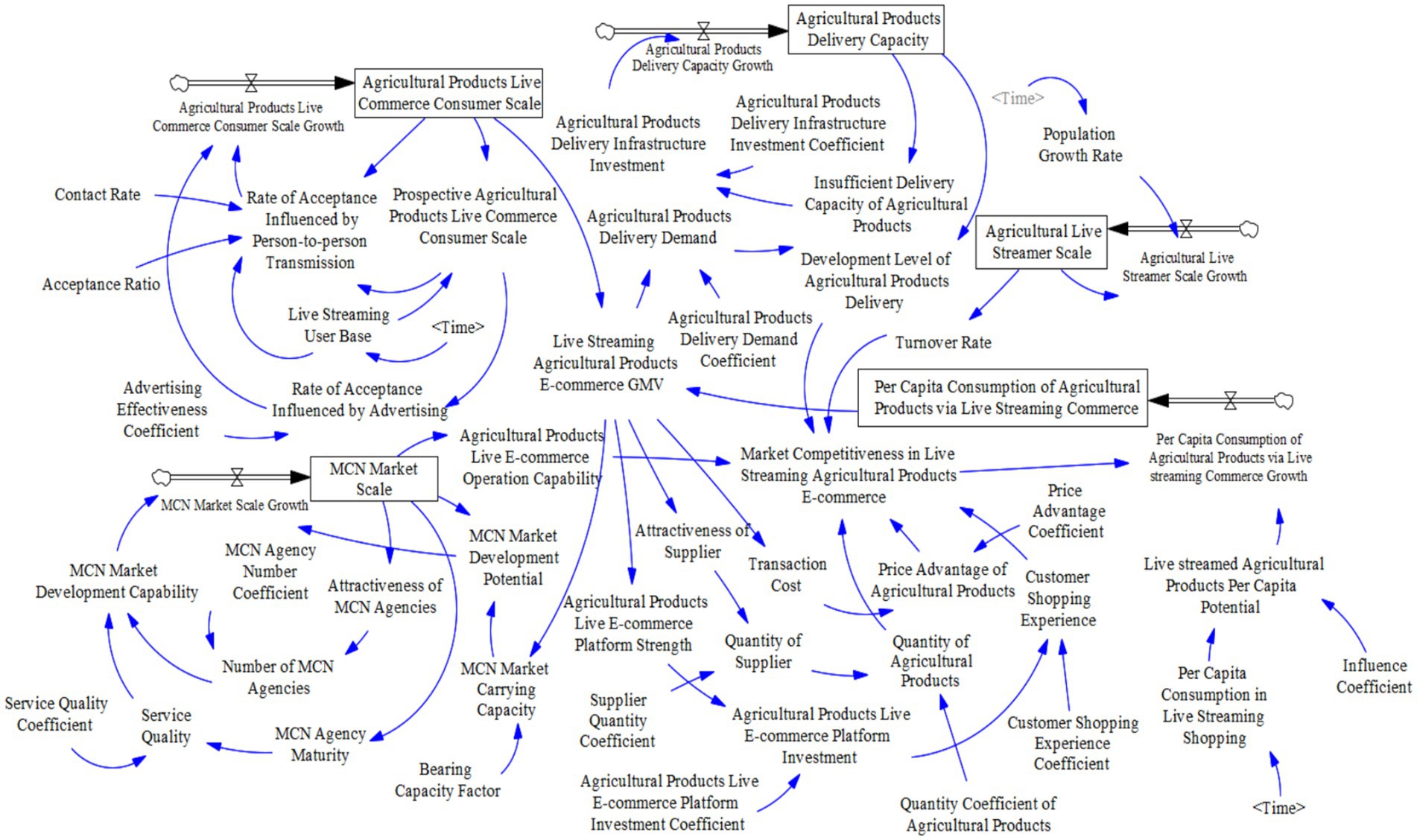
Figure 7. System dynamics flow diagram of an agricultural products live streaming e-commerce ecosystem.
3.4.2 Parametric equation
The system flow diagram characterizes the structure and features of the system through a detailed representation of system variables, while establishing corresponding mathematical equations based on the logical relationships between variables to enable quantitative system description.
3.4.2.1 Predation relationship model equations and parameters
(1) Agricultural Live Commerce Consumer Scale = INTEG [Agricultural Live Commerce Consumer Scale Growth, 1240.93];
(2) Agricultural Live Commerce Consumer Scale Growth = Rate of Acceptance Influenced by Person-to-person Transmission + Rate of Acceptance Influenced by Advertising;
(3) Rate of Acceptance Influenced by Person-to-person Transmission = Contact Rate*Acceptance Ratio*Prospective Agricultural Products Live Commerce Consumer Scale*Agricultural Live Commerce Consumer Scale/Live Streaming User Base;
(4) Rate of Acceptance Influenced by Advertising = Agricultural Live Commerce Consumer Scale*Advertising effectiveness coefficient;
(5) Prospective Agricultural Products Live Commerce Consumer Scale = Live Streaming User Base-Agricultural Live Commerce Consumer Scale.
3.4.2.2 Mutual-benefit relationship model equations and parameters
(1) Agricultural Products Delivery Capacity = INTEG [Agricultural Products Delivery Capacity Growth, 36];
(2) Agricultural Products Delivery Capacity Growth = Agricultural Products Delivery Infrastructure Investment;
(3) Agricultural products delivery infrastructure investment = Insufficient Delivery Capacity of Agricultural Products*Agricultural products delivery infrastructure investment coefficient;
(4) Insufficient Delivery Capacity of Agricultural Products = IF THEN ELSE(Agricultural Products Delivery Demand-Insufficient Delivery Capacity of Agricultural Products>0, Agricultural Products Delivery Demand-Insufficient Delivery Capacity of Agricultural Products, 0);
(5) Agricultural Products Delivery Demand = Live Streaming Agricultural Products E-commerce GMV*Agricultural Products Delivery Demand Coefficient.
3.4.2.3 Competition relationship model equations and parameters
(1) Per Capita Consumption of Agricultural Products via Live Streaming Commerce = INTEG [Per Capita Consumption of Agricultural Products via Live Streaming Commerce Growth, 11.68];
(2) Per Capita Consumption of Agricultural Products via Live Streaming Commerce Growth = Live Streaming Agricultural Products Per Capita Potential*Market Competitiveness in Live Streaming Agricultural Products E-commerce;
(3) Live Streaming Agricultural Products Per Capita Potential = Per Capita Consumption in Live Streaming Shopping-Per Capita Consumption of Agricultural Products via Live Streaming Commerce;
(4) Market Competitiveness in Live Streaming Agricultural Products E-commerce = Development Level of Agricultural Products Delivery*Turnover Rate*Agricultural Products Live E-commerce Operation Capability*Price advantage of Agricultural Products*Quantity of Agricultural Products*Customer Shopping Experience;
(5) Development Level of Agricultural Products Delivery = with lookup(Agricultural Products Delivery Capacity);
(6) Turnover Rate = with lookup(Agricultural Live Streamer Scale);
(7) Agricultural Products Live E-commerce Operation Capability = with lookup(MCN Market Scale);
(8) Price advantage of Agricultural Products = c*Price Advantage Coefficient;
(9) Transaction Cost = with lookup(Live Streaming Agricultural Products E-commerce GMV);
(10) Quantity of Agricultural Products = Number of Supplier;
(11) Number of Supplier = Attractiveness of Supplier*Supplier Quantity Coefficient;
(12) Attractiveness of Supplier = with lookup(Live Streaming Agricultural Products E-commerce GMV);
(13) Customer Shopping Experience = Agricultural Products Live E-commerce Platform Investment*Customer Shopping Experience Coefficient;
(14) Agricultural Products Live E-commerce Platform Investment = Agricultural Products Live E-commerce Platform Strength*Agricultural Products Live E-commerce Platform Investment Coefficient;
(15) Agricultural Products Live E-commerce Platform Strength = with lookup (Live Streaming Agricultural Products E-commerce GMV).
3.4.2.4 Parasitism relationship model equations and parameters
(1) MCN Market Scale = INTEG [MCN Market Scale Growth, 65.29];
(2) MCN Market Scale Growth = MCN Market Development Potential*MCN Market Development Capability;
(3) MCN Market Development Potential = MCN Market Carrying Capacity -MCN Market Scale;
(4) MCN Market Carrying Capacity = Live Streaming Agricultural Products E-commerce GMV*Bearing capacity factor;
(5) MCN Market Development Capability = Number of MCN Agencies*Service Quality;
(6) Number of MCN Agencies = Attractiveness of MCN Agencies*MCN Agency Number Coefficient;
(7) Attractiveness of MCN Agencies = with lookup (MCN Market Scale);
(8) Service Quality = MCN Agency Maturity*Service Quality Coefficient;
(9) MCN Agency Maturity = with lookup (MCN Market Scale).
3.5 Exogenous variables and initial values of the model
3.5.1 Exogenous variable
In this model, the exogenous variables are the live streaming user base and per capita consumption in live streaming shopping. Among these, the live streaming user base is predicted based on statistical data from the China Internet Network Information Center (CNNIC) spanning 2016 to 2024, using the Expert Modeler in time series analysis within SPSS 22, as detailed in Table 2.
The per capita consumption in live streaming shopping comprises two components: per capita expenditure on agricultural products and per capita expenditure on non-agricultural products. These values are derived by dividing the total transaction volume of live streaming e-commerce from 2016 to 2024 (obtained from the Wind database) by the corresponding annual live streaming user base. Subsequently, the Expert Modeler in time series analysis within SPSS 22 is employed for forecasting, as presented in Table 3.
3.5.2 Initial value of the state variable
In the model, we established five state variables, with their initial values all derived from historical data provided by relevant institutions in 2016. The initial value of the agricultural product live commerce consumer scale was set at 12.4093 million, the initial agricultural products delivery capacity at 3.6 billion orders, the initial MCN market scale at 6.529 billion yuan, the initial per capita consumption of agricultural products via live streaming commerce at 11.68 yuan, and the initial scale of agricultural live streamers at 13,900 individuals. These initial value settings ensure the accuracy and reliability of the model during the simulation process.
3.6 Model test
The simulation timeframe spans 30 years from 2016 to 2046, with an annual time step (Δt = 1 year). Model parameters were primarily calibrated using historical data from 2016 to 2024, sourced from authoritative databases including Wind, supplemented by literature review and survey findings for parameter estimation where necessary.
A comparative analysis between simulated outputs and empirical observations demonstrates satisfactory model validity, with all relative errors maintained within acceptable thresholds. This confirmation of model robustness enables reliable application for subsequent simulation and scenario analysis (Table 4).
4 Simulation analysis of system model
4.1 Prediction analysis of system index
This model simulates the development trends of major subjects in the agricultural product live streaming e-commerce ecosystem from 2016 to 2046, including agricultural products live commerce consumer scale, per capita consumption of agricultural products via live streaming commerce, agricultural products delivery capacity, MCN market scale, and agricultural live streamer scale. The simulation results are shown in Figures 8–12.
(1) Agricultural products live commerce consumer scale.
Driven by the dynamic interaction between live streaming platforms and consumers (conceptualized as a predator–prey relationship), the agricultural product live streaming consumer base exhibits distinct phased growth patterns from 2016 to 2046. From 2016 to 2020, the scale of agricultural product live streaming consumers was in the initial stage of slow growth. During this period, as an emerging sales model, agricultural products live streaming was in the stage of market exploration and technical accumulation, with low consumer acceptance, resulting in a relatively flat growth. From 2020 to 2030, the scale of agricultural product live streaming consumers entered a period of rapid growth. With the maturity of live streaming technology, the promotion of e-commerce platforms, and the improvement of consumers’ trust in purchasing agricultural products online, the market scale has expanded rapidly. From 2030 to 2040, the growth rate of the consumer scale gradually slowed down and entered a period of stable growth. At this time, the market may have approached a phased saturation, competition intensified, and the industry began to shift to refined operations. After 2040, the scale of agricultural product live streaming consumers tends to stabilize, and the market enters a mature stage. The curve is close to flat, indicating that the growth space is limited, and the industry may turn to the in-depth development of innovative models or segmented fields.
(2) Per Capita consumption of agricultural products via live streaming commerce
The competitive dynamics between e-commerce platforms and content platforms have driven a distinct phased growth pattern in per capita consumer spending on agricultural products purchased via live streaming between 2016 and 2046. From 2016 to 2020, per capita expenditure remained low and grew slowly, reflecting a market incubation period characterized by limited consumer awareness and trust in live streaming purchases of agricultural products, resulting in generally low spending levels.
Subsequently, between 2020 and 2030, per capita spending entered a phase of explosive growth. This surge was primarily fueled by the maturation of live streaming e-commerce infrastructure, optimizations in agricultural supply chains, and the solidification of consumer habits regarding online shopping. However, the growth rate moderated between 2030 and 2040 as the market gradually matured. During this stage, consumption growth shifted from quantity-driven expansion to quality-focused enhancement, with consumers prioritizing product quality and shopping experiences, consequently driving a steady increase in average spending per transaction.
Post-2040, per capita spending on agricultural products via live streaming reached a plateau phase, with the growth curve flattening significantly. This indicates the market had attained a state of relative saturation. By this point, the competitive landscape had largely stabilized, making innovative service models and differentiated products crucial for sustaining consumption levels. Collectively, these three decades witnessed the evolution of live streaming purchases of agricultural products from an emerging sales channel into a mainstream consumption method.
(3) Agricultural products delivery capacity
Driven by the mutually beneficial relationship between live streaming e-commerce platforms and logistics enterprises, the logistics and distribution capacity for agricultural products exhibited distinct phased development characteristics from 2016 to 2046. Between 2016 and 2020, this capacity was in a nascent stage of slow improvement, with annual distribution volumes hovering around 2 million units. Subsequently, from 2020 to 2030, it entered a period of rapid expansion, with volumes surging from 2 million to over 4 million units. This growth was propelled by government investment in new infrastructure initiatives, technological upgrades by logistics firms, and the refinement of fresh produce delivery networks.
Between 2030 and 2040, annual distribution volumes continued to grow, albeit at a moderated pace. The industry began shifting its focus toward enhancing distribution efficiency and service quality, moving beyond mere scale expansion. The application of innovative technologies, such as smart warehousing and drone delivery, for instance, drove the sector’s transition toward high-quality development. Post-2040, the agricultural product logistics and distribution system reached maturity, stabilizing annual volumes at a high level of approximately 6 million units. With the market structure largely solidified, the competitive emphasis pivoted toward refined operations and differentiated services.
Collectively, these three decades witnessed the logistics capacity for agricultural products achieve a leapfrog development, evolving from foundational infrastructure construction to comprehensive modernization.
(4) MCN market scale
Driven by the parasitic relationship between live streaming e-commerce platforms and MCN (Multi-Channel Network) agencies, the MCN market exhibited distinct phased expansion characteristics from 2016 to 2046. Between 2016 and 2020, the market was in its nascent stage, experiencing relatively slow growth. During this period, the industry was exploratory, with business models and profit mechanisms yet to mature.
From 2020 to 2030, the MCN market underwent explosive growth. This surge was fueled collectively by the rise of live streaming e-commerce, the diversification of content monetization channels, and substantial capital injections. Subsequently, between 2030 and 2040, market expansion entered a phase of rational growth. Competitive differentiation became apparent, with leading MCN agencies consolidating their positions through specialization in vertical niches and global expansion strategies.
Post-2040, the MCN industry reached maturity, stabilizing at a high level of approximately 15 trillion yuan. A pronounced Matthew Effect emerged, where innovation capability and resource integration became critical competitive advantages. Collectively, these three decades witnessed the MCN sector evolve from an emerging business model into a vital component of the digital economy.
(5) Agricultural live streamer scale
Driven by the mutually beneficial relationship between live streaming e-commerce platforms and farmer broadcasters, the scale of farmer broadcasters demonstrated a distinct staged growth pattern from 2016 to 2046. During the 2016–2020 period, the industry experienced a slow initial development phase, with the broadcaster base remaining at a relatively low level below 2,000 individuals. Growth during this stage was constrained by limited farmer awareness of live streaming e-commerce and insufficient skills training and infrastructure support.
Subsequently, from 2020 to 2028, the scale of farmer broadcasters entered its first rapid expansion phase. This growth was catalyzed by government rural revitalization support policies and enhanced agricultural products live streaming initiatives from major platforms, collectively fostering the emergence of the first substantial cohort of farmer broadcasters. The 2028–2036 period then witnessed explosive growth, characterized by significantly increased annual growth rates in farmer broadcaster numbers. This acceleration was primarily attributable to improved rural digital infrastructure, mature live streaming training systems, and the expanding market scale of agricultural e-commerce.
Post-2036, the farmer-broadcaster population stabilized at a high level of approximately 6,000 individuals. As the market reached maturity, industry competition intensified, making professional expertise and distinctive content specialization critical for sustainable development. Collectively, these three decades transformed farmer broadcasting from sporadic attempts into a scaled and professionalized occupation.
4.2 Analysis of system simulation results
Fundamentally, the dynamic development of the agricultural product live streaming e-commerce ecosystem is modeled based on system dynamics principles. Simulations of the system’s operation are conducted by varying key parameters, thereby providing references for decision-making. Consequently, it is necessary to select specific variables within the established system dynamics model of the agricultural product live streaming e-commerce ecosystem for simulation.
This study primarily aims to analyze the impact of predation, mutual-benefit, competition, and parasitism relationships among the main populations on the evolutionary trajectory of the agricultural products live streaming e-commerce ecosystem. The market transaction volume of agricultural product live streaming e-commerce is selected as the key performance metric for ecosystem development. By altering factors such as agricultural products live commerce consumer scale, per capita consumption of agricultural products via live streaming commerce, agricultural products delivery capacity, MCN market scale, agricultural live streamer scale, the influence of these four ecological relationships on the ecosystem is observed. Based on the simulation results, corresponding cultivation suggestions are proposed to promote the sustainable and healthy operation of the entire agricultural products live streaming e-commerce ecosystem. The key findings are summarized.
(1) Agricultural products live commerce consumer scale
To investigate the impact of the predation relationship between live streaming e-commerce platforms and consumers on the agricultural product live streaming ecosystem, this study doubled or tripled the increment in the scale of agricultural products live commerce consumers. The relationship between the simulation results for consumer scale and the development of market transaction volume is illustrated in Figure 13. The results clearly demonstrate that increasing the scale of live commerce consumers does not significantly enhance the live streaming of agricultural products e-commerce GMV.
(2) Per Capita consumption of agricultural products via live streaming commerce
To examine the effect of competitive relationships among live streaming e-commerce platforms on the ecosystem, the study doubled or tripled the increment in per capita consumption of agricultural products via live streaming commerce. The relationship between these simulation results and live streaming agricultural products e-commerce GMV is shown in Figure 14. The findings clearly indicate that increasing per capita consumption significantly influences live streaming agricultural products e-commerce GMV.
(3) Agricultural products delivery capacity
To assess the impact of the mutual-benefit relationship between live streaming platforms and logistics enterprises, the increment in agricultural product delivery capacity was doubled or tripled. The relationship between the delivery capacity simulation results and live streaming agricultural products e-commerce GMV is presented in Figure 15. These results clearly show that enhancing agricultural products delivery capacity does not substantially increase live streaming agricultural products e-commerce GMV.
(4) MCN market scale
To analyze the effect of the parasitic relationship between live streaming platforms and MCN agencies, the increment in the MCN market scale was doubled or tripled. The relationship between the MCN market scale simulation results and live streaming agricultural products e-commerce GMV is depicted in Figure 16. The results clearly indicate that expanding the MCN market scale produces a comparatively noticeable increase in live streaming agricultural products e-commerce GMV.
(5) Agricultural live streamer scale
To investigate the mutual-benefit relationship between live streaming platforms and agricultural live streamers, the increment in agricultural live streamer scale was doubled or tripled. The relationship between these simulation results and live streaming agricultural products e-commerce GMV is shown in Figure 17. The findings clearly demonstrate that increasing the scale of agricultural product streamers does not significantly enhance live streaming agricultural products e-commerce GMV; instead, it leads to a declining trend in live streaming agricultural products e-commerce GMV.
Integrating these simulation results, the study reveals that within the agricultural products live streaming ecosystem, the ecological relationships among entities promote the development of key actors such as MCN agencies, logistics enterprises, and agricultural live streamers, ultimately increasing live streaming agricultural products e-commerce GMV and fostering the growth of the live streaming industry economy. Furthermore, competitive and parasitic relationships were found to significantly drive system development, while predation and mutual-benefit relationships exhibited less pronounced effects. Consequently, practical efforts to promote ecosystem development should prioritize cultivating and safeguarding key entities like live streaming e-commerce platforms and MCN agencies, thereby fostering the sustainable and healthy evolution of the agricultural products live streaming e-commerce ecosystem.
5 Discussion
From an ecosystem perspective, this study focuses on agricultural products live streaming e-commerce and proposes a conceptual model of the agricultural products live streaming e-commerce ecosystem. It further constructs a system dynamics model to simulate the development of this ecosystem. The simulation results indicate that the predation, mutual-benefit, competition, and parasitism relationships among various entities within the system positively influence the development of the agricultural products live streaming e-commerce ecosystem. Specifically, the competition relationship between e-commerce platforms and content platforms has the most significant impact; the parasitism relationship between live streaming e-commerce platforms and MCN agencies exhibits a relatively notable influence; while the predation relationship between live streaming e-commerce platforms and consumers, as well as the mutual-benefit relationships between live streaming e-commerce platforms and logistics enterprises and agricultural live streamers, have less pronounced effects.
First, this paper establishes a conceptual model of the agricultural product live-streaming e-commerce ecosystem. The business ecosystem theory proposed by Moore (1993) provides a theoretical framework for research in this domain. Hu et al. (2009) introduced the concept of the e-commerce ecosystem, and Wang and Ding (2015) first put forward the notion of an agricultural product e-commerce ecosystem, defining it as a dynamic organic whole composed of agricultural product producers, processors, distributors, consumers, e-commerce enterprises, stakeholder groups, and the external environment. These studies demonstrate that ecosystem theory can effectively explain the clustering phenomena within the e-commerce industry. In contrast, this research focuses on the emerging model of agricultural products live streaming e-commerce and proposes a theoretical framework for the agricultural products live streaming e-commerce ecosystem, representing a recent extension of the (agricultural product) e-commerce ecosystem concept. This study offers valuable insights for future research.
Second, a system dynamics model was constructed to simulate the dynamic evolution of the agricultural products live streaming e-commerce ecosystem. Lei (2017) employed system dynamics theory to explore the population relationships and development trends within the online retail ecosystem. Xue et al. (2020) proposed a conceptual model of the dynamic mechanism of the cross-border e-commerce ecosystem and used Vensim PLE software to simulate its development trends. These studies confirm the feasibility and scientific rigor of applying ecosystem theory and system dynamics methods to investigate the dynamic evolution of e-commerce ecosystems. Conversely, this study delves into the ecological relationships—predation, mutual-benefit, competition, and parasitism—among key entities within the agricultural products live streaming e-commerce ecosystem. Through in-depth analysis of acquired data, it examines the extent to which different ecological relationships influence the development of the ecosystem. The findings reveal that competition relationships have the most significant impact, followed by parasitism relationships. This suggests that emphasis should be placed on nurturing entities such as live streaming e-commerce platforms and MCN agencies to promote the sustainable development of the agricultural products live streaming e-commerce industry.
This study also has certain limitations that need to be addressed in future research. The paper aims to construct a general model of the agricultural products live streaming e-commerce ecosystem, and the selected variables are universal. However, in practical applications, ecosystems in different regions often exhibit unique characteristics, necessitating flexible adjustments to the variables based on actual conditions. Future research could further explore the specificities of ecosystems in various regions to refine the model and enhance its practicality.
6 Conclusions and recommendations
Based on the system dynamics theory, this study explores the dynamic development of the agricultural products live streaming e-commerce ecosystem by constructing a simulation dynamic system. It simulates the development trends of the agricultural products live streaming e-commerce ecosystem under different ecological relationships. The simulation results show that the predation relationship, mutual-benefit relationship, competitive relationship, and parasitic relationship among various subjects in the system all have a positive impact on the development of the agricultural product live streaming e-commerce ecosystem. Among them, the competitive relationship between e-commerce platforms and content platforms has the most obvious impact on the ecosystem; the parasitic relationship between live streaming e-commerce platforms and MCN agencies has a relatively obvious impact; while the predation relationship between live streaming e-commerce platforms and consumers, as well as the mutual-benefit relationships between live streaming e-commerce platforms and logistics enterprises, and between live streaming e-commerce platforms and agricultural live streamers, have a relatively less obvious impact. Therefore, in practice, priority should be given to cultivating subjects such as live streaming e-commerce platforms and MCN agencies to promote the sustainable development of the agricultural products live streaming industry.
Based on the aforementioned research findings, this study proposes corresponding management recommendations for agricultural live streaming e-commerce platforms and MCN agencies.
For live streaming e-commerce platforms, as the core entity in the agricultural products live streaming e-commerce ecosystem, they should strengthen ecological construction and promote synergistic development among various entities. The sustainable development of agricultural product live-streaming e-commerce relies on the collaboration of multiple entities and factors. As the central player, live-streaming e-commerce platforms can integrate resources such as farmer streamers, MCN agencies, and logistics enterprises to achieve information sharing and risk sharing, thereby forming a beneficial interaction mechanism. Meanwhile, these platforms can optimize technology and services to enhance user experience, for instance, by increasing consumer engagement through personalized recommendations and interactive features. Furthermore, live streaming e-commerce platforms can collaborate closely with MCN agencies to help farmer streamers improve their live streaming skills and content quality, thereby enhancing their market competitiveness. In terms of logistics, these platforms can promote partnerships with efficient logistics enterprises to ensure the timeliness and safety of agricultural product deliveries, further boosting consumer satisfaction. Through these measures, live streaming e-commerce platforms can drive the healthy development of the entire ecosystem and achieve sustainable growth.
For MCN agencies, as critical intermediaries connecting streamers, platforms, and supply chains, their development should focus on specialization and ecological collaboration. They should deepen their expertise in the agricultural product vertical, cultivate streamer teams with agricultural knowledge, and enhance consumer trust through professional content. Simultaneously, MCN agencies should strengthen strategic partnerships with live streaming e-commerce platforms to secure traffic and policy support, and establish systematic training systems for farmer streamers to help them improve their live-streaming skills and fan management capabilities. MCN agencies can also collaborate closely with suppliers and logistics enterprises to ensure product quality and delivery efficiency, introducing traceability technologies to enhance transparency. Additionally, MCN agencies should explore diversified business models, such as brand agency operations and private traffic development, while strictly adhering to industry regulations to avoid compliance risks. Through data-driven operations and participation in agricultural support initiatives, MCN agencies can not only enhance their own competitiveness but also contribute to rural revitalization, ultimately achieving symbiotic prosperity with the ecosystem.
Data availability statement
Publicly available datasets were analyzed in this study. This data can be found at https://www.wind.com.cn/portal/zh/EDB/index.html.
Author contributions
GZ: Writing – original draft, Investigation, Software, Visualization, Funding acquisition, Writing – review & editing, Resources, Methodology, Formal analysis, Validation, Project administration, Conceptualization, Data curation, Supervision.
Funding
The author(s) declare that no financial support was received for the research and/or publication of this article.
Conflict of interest
The author declares that the research was conducted in the absence of any commercial or financial relationships that could be construed as a potential conflict of interest.
Generative AI statement
The author(s) declare that no Gen AI was used in the creation of this manuscript.
Any alternative text (alt text) provided alongside figures in this article has been generated by Frontiers with the support of artificial intelligence and reasonable efforts have been made to ensure accuracy, including review by the authors wherever possible. If you identify any issues, please contact us.
Publisher’s note
All claims expressed in this article are solely those of the authors and do not necessarily represent those of their affiliated organizations, or those of the publisher, the editors and the reviewers. Any product that may be evaluated in this article, or claim that may be made by its manufacturer, is not guaranteed or endorsed by the publisher.
Footnotes
1. ^iresearch.2023 China Live Streaming E-commerce Industry Research Report[R]. 2023.
2. ^Notice of The State Council on Printing and Distributing the 14th Five-Year Plan for Promoting Modernization of Agriculture and Rural Areas, https://www.gov.cn/zhengce/content/2022-02/11/content_5673082.htm.
3. ^Opinions of the Central Committee of the Communist Party of China and The State Council on Doing a Good Job in Key Tasks for Comprehensively Promoting Rural Revitalization in 2022 _ Relevant Central Documents _ website of the Chinese government, https://china.huanqiu.com/article/46vI0jtmy1l.
References
Bharadwaj, N., Ballings, M., Naik, P. A., Moore, M., and Arat, M. M. (2022). A new livestream retail analytics framework to assess the sales impact of emotional displays. J. Mark. 86, 27–47. doi: 10.1177/00222429211013042
Chen, J., and Yang, X. (2016). Connotation of internet business ecosystem. J. Beijing University of Posts Telecommunications (Soc. Sci. Edition) 18, 45–52.
Chi, R., and Le, L. (2017). A new industrial ecological micro-system: Taobao village industrial agglomeration. J. Zhejiang University Technol. (Soc. Sci.) 16, 383–389.
Feng, H. (2023). Problems and governance strategies in the live streaming e-commerce industry. People’s Tribune 12, 104–106.
Gu, Y. (2020). Research on the influence of e-commerce live broadcast on consumers’ purchasing decision. Price: Theory Practice. 124–127. doi: 10.19851/j.cnki.CN11-1010/F.2020.02.286
Guo, N., and Li, H. W. (2019). System dynamic research on interactive development of rural e-commerce and revitalization. Chin. J. Eco-Agric. 27, 654–664. doi: 10.13930/j.cnki.cjea.180933
Guo, H., and Qu, J. (2020). Research on the sustainable development of live-streaming sales to assist farmers. People’s Tribune. 74–76.
Han, X., and Xu, Z. (2020). Impacts of e-commerce anchor attributes on consumers’ willingness to buy online: research based on the grounded theory. Foreign Econ. Manag. 42, 62–75. doi: 10.16538/j.cnki.fem.20200820.301
Hou, Y., and Yang, C. (2015). Research on selection strategies of business model for the network platform business ecosystem. Soft Sci. 29, 30–34. doi: 10.13956/j.ss.1001-8409.2015.11.07
Hu, C., Chen, W., Zhou, Y.-j., Chen, C., and Sun, S.-y. (2023). Regulation mechanism of live streaming e-commerce based on evolutionary game theory. J. Manag. Sci. China 26, 126–141. doi: 10.19920/j.cnki.jmsc.2023.06.008
Hu, G., Lu, X., and Huang, L. (2009). Research on e-business ecosystem and its coordination mechanism—a case study of Libaba group. Soft Sci. 23, 110–116. doi: 10.19616/j.cnki.bmj.2009.06.020
Hu, L., Yang, B., Cao, S., and Li, W. (2017). Structural evolution stages and investment strategies in agricultural product E-commerce ecosystems. J. Commer. Econ. 67–69. Available online at: https://link.cnki.net/urlid/10.1286.F.20170313.0839.044
Hua, Y. (2020). “Agricultural products + livestream” study on the inverse supply chain model. Price: Theory & Practice. 129–132. doi: 10.19851/j.cnki.cn11-1010/f.2020.07.220
Huang, L., Zhao, W., and Dou, Z. (2017). Strategy simulation analysis for rural e-commerce ecosystem using system dynamics. J. Guangzhou University (Soc. Sci. Edition) 16, 33–42.
Jia, W., and Ni, Y. (2025). Systematic research on the development of agricultural product e-commerce platform. J. Syst. Sci. 33, 75–78. Available online at: https://link.cnki.net/urlid/14.1333.N.20231031.1635.002
Lei, B. (2017). Population growth of e-retailing ecosystems: a system dynamics approach. Manag. Rev. 29, 152–164. doi: 10.14120/j.cnki.cn11-5057/f.2017.06.025
Li, C., Cao, Y., Wang, C., and Hao, L. (2022). Evolutionary game simulation of tripartite strategy in e-commerce live streaming under platform regulation. Complex Syst. Complex. Sci. 19, 34–44. doi: 10.13306/j.1672-3813.2022.01.005
Li, C., Feng, L., Han, F., and Cheng, Y. (2015). Dynamic evolutionary game analysis of the E-business ecosystem. J. Syst. Sci. 23, 75–78.
Li, J., Zhao, Y., and Chen, M. (2020). System dynamics-based simulation analysis of cross-border E-commerce development. J. Commer. Econ. 74–77.
Liang, X. (2019). Strategy selection and implementation for constructing E-commerce ecosystems in rural China during the smart economy era. Agric. Econ. 135–137.
Lin, Y., Dai, Y., and Chen, X. (2021). Happiness begets money: emotion and engagement in live streaming. J. Mark. Res. 58, 417–438. doi: 10.1177/00222437211002477
Liu, Y., and Li, N. (2021). Legal regulation of false advertising in livestreaming e-commerce. Intellect. Prop. 68–82. doi: 10.33731/32021.239562
Liu, F., Meng, L., Chen, S., and Duan, S. (2020). The impact of network celebrities’ information source characteristics on purchase intention. Chin. J. Manag. 17, 94–104.
Liu, P.-s., and Shi, Y.-d. (2020). Research on the influencing mechanism of live broadcasting marketing pattern on consumers’ purchase decision. China Business Market 34, 38–47. doi: 10.14089/j.cnki.cn11-3664/f.2020.10.004
Liu, Z., Yang, J., and Ling, L. (2020). Exploring the influence of live streaming in mobile commerce on adoption intention from a social presence perspective. Int. J. Mobile Human Computer Interaction 12, 53–71. doi: 10.4018/IJMHCI.2020040104
Lu, B., Tan, C., Wang, F., and Hang, X. (2020). Construction and mechanisms of exogenous rural e-commerce ecosystem based on the rural case of Taobao. J. Syst. Manag. 29, 762–771.
Mei, A., and Hou, S. (2021). Regulatory governance of E-commerce livestreaming in the live streaming+era. E-Government. 28–37. doi: 10.16582/j.cnki.dzzw.2021.03.003
Pan, X. (2021). Development status and governance mechanism of webcast E-commerce in China—statistical analysis based on 2020 Kuai live broadcast data. Acad. Exch. 100–109.
Park, H. J., and Limin, L. (2020). The effects of match-ups on consumer attitudes toward internet celebrities and their live streaming contents in the context of product endorsement. J. Retail. Consum. Serv. 52:101934. doi: 10.1016/j.jretconser.2019.101934
Qiao, H., Xu, J., and Zhang, S. (2023). Research on the impact of community e-commerce value creation based on system dynamics. System Eng. Theory Practice 43, 2615–2631. doi: 10.12011/SETP2023-0101
Su, H. (2021). Legal regulations for livestream marketing. China Business Market 35, 97–104. doi: 10.14089/j.cnki.cn11-3664/f.2021.01.010
Sun, Y., Shao, X., Li, X., Guo, Y., and Nie, K. (2019). How live streaming influences purchase intentions in social commerce: an it affordance perspective. Electron. Commer. Res. Appl. 37:100886. doi: 10.1016/j.elerap.2019.100886
Wang, B. Y. (2021). The essence, logic and trend of livestreaming e-commerce. China Business Market 35, 48–57. doi: 10.14089/j.cnki.cn11-3664/f.2021.04.005
Wang, X., Cheng, Y., Tian, X., Xu, Z., and Chen, J. (2022). Four-party evolutionary game for e-commerce ecosystem. Oper. Res. Trans. 26, 23–42. doi: 10.15960/j.cnki.issn.1007-6093.2022.01.002
Wang, S., and Ding, Z. (2015). The agricultural products electric commercial ecological system—a theoretical research framework. China Rural Surv. 39–48+70+96. doi: 10.20074/j.cnki.11-3586/f.2015.04.004
Wang, X., and Lin, Y. (2022). The government mechanisms for the construction of “roll-over” events in live streaming e-commerce. Bus. Manag. J. 44, 178–191. doi: 10.19616/j.cnki.bmj.2022.02.011
Xiao, Y., Wang, X., Yu, J., and Zhao, C. (2025). Live-streaming e-commerce: management challenges and potential research directions. Chin. J. Manage. Sci. 33, 2241–2258. doi: 10.1177/10591478241270119
Xie, Y., Li, C., Gao, P., and Liu, Y. (2019). The effect and mechanism of social presence in live marketing on online herd consumption from behavioral and neurophysiological perspectives. Adv. Psychol. Sci. 27, 990–1004. doi: 10.3724/SP.J.1042.2019.00990
Xue, C., Zhou, M., and Cao, W. (2020). Dynamic mechanism of cross-border e-commerce ecosystem based on system dynamics. Ind. Eng. J. 23, 84–92.
Ye, C., and Rui, W. (2017). Government mechanisms of live streaming platform: case studies from the two-sided platform perspective. J. Manage. Case Stud. 10, 355–363.
You, J., and Peng, L. (2017). Research on the ecological characteristics of E-commerce ecosystems. Enterprise Economy. 115–122. doi: 10.13529/j.cnki.enterprise.economy.2017.08.017
Yue, X. (2020). The content production and optimization path for e-commerce live-streaming “sales promotion”. View Publishing. 64–66. doi: 10.16491/j.cnki.cn45-1216/g2.2020.19.019
Zan, M., and Wang, Z. (2020). Agricultural product e-commerce live streaming: a new model of e-commerce poverty alleviation. Issues Agricultural Economy. 77–86. doi: 10.13246/j.cnki.iae.2020.11.008
Zeng, Y., Ma, C., Li, L., and Guo, H. (2022). Live streaming e-commerce and the value recreation of agricultural marketing from rural to urban areas: mechanism and implementation paths. Issues Agricultural Economy. 108–117. doi: 10.13246/j.cnki.iae.20210909.002
Zhang, Q., Sun, S., Wu, S., and Li, D. (2019). A study on the continuous growth of grassroot E-entrepreneur groups in Taobao Village. J Agrotech Econ. 121–134. doi: 10.13246/j.cnki.jae.2019.01.011
Zhang, B., Zhang, Q., and Zhao, C. (2021). The influence of webcast characteristics on consumers’ purchase intention under E-commerce live broadcasting mode—the mediating role of consumer perception. China Business Market 35, 52–61. doi: 10.14089/j.cnki.cn11-3664/f.2021.06.005
Keywords: agricultural products, live streaming e-commerce, ecosystem, system dynamics, China
Citation: Zhao G (2025) Agricultural products live streaming E-commerce ecosystem dynamics research. Front. Sustain. Food Syst. 9:1685996. doi: 10.3389/fsufs.2025.1685996
Edited by:
Guoqing Zhao, Swansea University, United KingdomReviewed by:
Bo Wen, Swansea University, United KingdomHuilan Chen, University of Plymouth, United Kingdom
Copyright © 2025 Zhao. This is an open-access article distributed under the terms of the Creative Commons Attribution License (CC BY). The use, distribution or reproduction in other forums is permitted, provided the original author(s) and the copyright owner(s) are credited and that the original publication in this journal is cited, in accordance with accepted academic practice. No use, distribution or reproduction is permitted which does not comply with these terms.
*Correspondence: Guoyu Zhao, MTI5OTA5NTAwNkBxcS5jb20=
 Guoyu Zhao
Guoyu Zhao